

Weather wise it was not a very good start to the day. At about 09:40 hrs the sky’s opened up with a downpour reminiscent of a tropical storm. Fortunately, once this had cleared the remainder of the day was reasonable with sun between overcast periods and only a few light showers, very unexpected, but appreciated.
On arrival at Cinder Hill Field Neil commenced marking out trench one. While this was going on the rest of the team moved the tools and tool bin up from Bottoms to Cinder Hill Field Photo 1. Having the tools immediately to hand will make life a bit easier. No more carrying tools up the hill and back down again at each dig.
Once Neil had marked out the trench the team commenced de-turfing the trench. Photo 2. The removed turfs were neatly stacked on plastic sheeting to the east of the trench Photo 3. Sufficient space has being left between the trench and the turf heap to allow easy access around the trench border and to allow for any possible extensions of the trench in an easterly direction. As this trench is fairly large the complete de-turfing operation took some time. On completion of the de-turfing, Photo 4, the soil surface of the trench was levelled off, the removed soil being used to hold down the soil spoil heap plastic base sheet.
Trench one is now ready for excavations to start on Saturday 16th March.
Warning signs have been put up around the work area in an attempt to discourage members of the public from venturing into the dig areas. Trench one has been roped off, again to try and discourage members of the public from entering the trench Photo 5.
Neil has marked out a second trench, trench 2, to the west of trench 1, as this trench is considerably smaller than trench 1, de-turfing will commence on Saturday and should be ready for excavating by Saturday lunch time.

Photo 1

Photo 2

Photo 4

Photo 5

Photo 3
Due to adverse weather conditions – continuous heavy rain – Saturday’s dig was cancelled.
Sunday’s dig will go ahead as planned, provided the ground conditions are reasonable. As the site is elevated it is hoped the drainage will be adequate to permit working.
Weather was a bit ominous at the start of the trek up to the dig site. A heavy hail shower turned most of the area white for a time. The rest of the day was mixed but it did not cause any problems.
14 diggers on site today, an excellent turn out
Trench 1 (7 metres x 5 metres, orientated north/south)
As we had an excellent number of team members at the dig Neil was able to allocate six of the team to trowelling the trench to remove approx. 10cm depth of top soil. Photo 1. The first interesting find of the day appears to be a small Medieval Gritty Ware ring or bead. Photos 2 and 3. The function of the object is up for debate, Neil has never seen an example of this type of Gritty Ware object before so is unable to identify its purpose. A casual look through Google failed to produce any similar objects. Maybe the site has produced the first of its kind to be excavated.
Another interesting find was a very small red glass bead, Photo 4. 20/20 vision was definitely needed to spot this item. A varied selection of different sizes of late pottery sherds were also uncovered. Photo 5.
Trench 2 (6 metres x 2.5 metres, orientated west/east)
This trench was marked out and de-turfed very quickly, a credit to the team carrying out the work. Once the de-turfing was completed they started removing the top soil. By the end of the day there was evidence of at least three different contexts in the trench, so this could prove a complicated trench to understand as, so far, only half of the trench has had the top soil removed. There could, therefore, be further context changes to be revealed. Finds from this trench were very few; hopefully early days yet. Photos 6 & 7.
Photos 8,9,10 additional scenes
For your information: The next three dig dates have been posted on the home page of the group’s web site. Further dates will be posted in the near future.

Photo 1

Photo 2

Photo 3

Photo 5

Photo 4

Photo 6
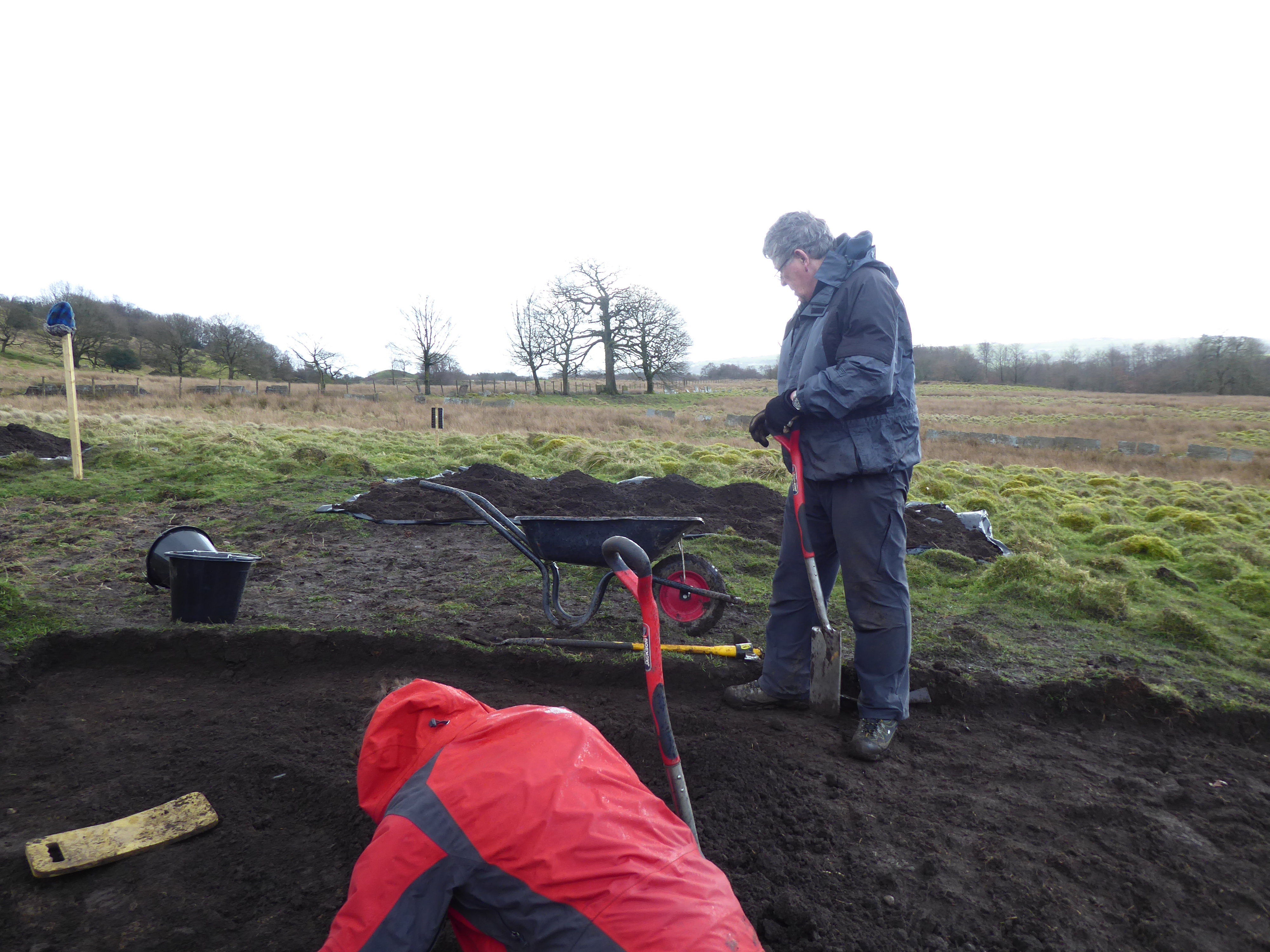
Photo 7

Photo 8

Photo 9

Photo 10
Weather: Cool, dry and partly overcast, some periods of sun shine.
At the start of the digging season two members offered to dowse the site to see if they could detect any hot spots which may be worthwhile investigating. Unfortunately, they were unable to attend the dig so could not carry out the exercise.
Today another member brought two dowsing rods to see if anyone could get a response. The results were interesting and amusing. One member achieved good results in a number of places and obtained the same results when returning to those areas, photos 1 & 2. Other members had the same results in the same spots. Whereas most participants ended up with the dowsing rods crossing, two members had the opposite results - the dowsing rods parted and ended up resting on the upper arms. When time permits the exercise will be repeated and, out of curiosity, a couple of the detection locations will be excavated to see if there is anything there.
Trench 1 (7 metres x 5 metres, orientated north/south)
Work continued removing the top soil from the trench, although good progress was made there is still some soil left to be removed, photo 3. The task should be completed by midday tomorrow. A number of small finds were made, one being an extremely small blue glass bead. The remainder consisted mostly of small sherds of pottery. One piece was dated to the mediæval period, while other sherds were estimated to be early 18th century and late 18th to early 19th century.
Considering the size of the area being cleared of top soil the number of finds has been disappointing. Hopefully this trend will be reversed once we start going deeper.
Trench 2 (6 metres x 2.5 metres, orientated west/east)
It is a similar story with this trench - there is a small amount of top soil left to be removed which shouldn’t take more than 30 minutes, photo 4. It will then be a case of recording the context and taking a number of levels before further excavations can take place.
The finds in this trench were very poor, a few small sherds of late 18th century and early 19th century pottery and very little else of interest. Early days yet.

Photo 1

Photo 2

Photo 3

Photo 4
Weather : Windy with cloud and sunny spells. A cool day, especially in the wind.
Trench 1 (7 metres x 5 metres, orientated north/south)
The remaining topsoil was removed and the trench is now ready to be recorded and levelled before the next layer is dug. A feature in the south end of the trench was excavated and revealed what is probably the edge of the continuation of the trackway, which was uncovered in Trench 1 of last year’s dig. Very few finds were recovered, mainly 18th and 19th century small sherds. (Photo 1)
Trench 2 (6 metres x 2.5 metres, orientated west/east)
Again, the topsoil was taken out (Photo 2) and diggers started to remove the next layer, which revealed another layer containing charcoal and furnace lining fragments. In the south west corner of the trench a feature was revealed which is probably a drain. (Photo 3) This feature will need to be investigated further in the coming weeks. There were very few finds, again small sherds of 18th and 19th century pottery.
Now the topsoil has been removed in both trenches, hopefully any archaeology in the trenches will begin to be uncovered in the next few weeks.

Photo 1
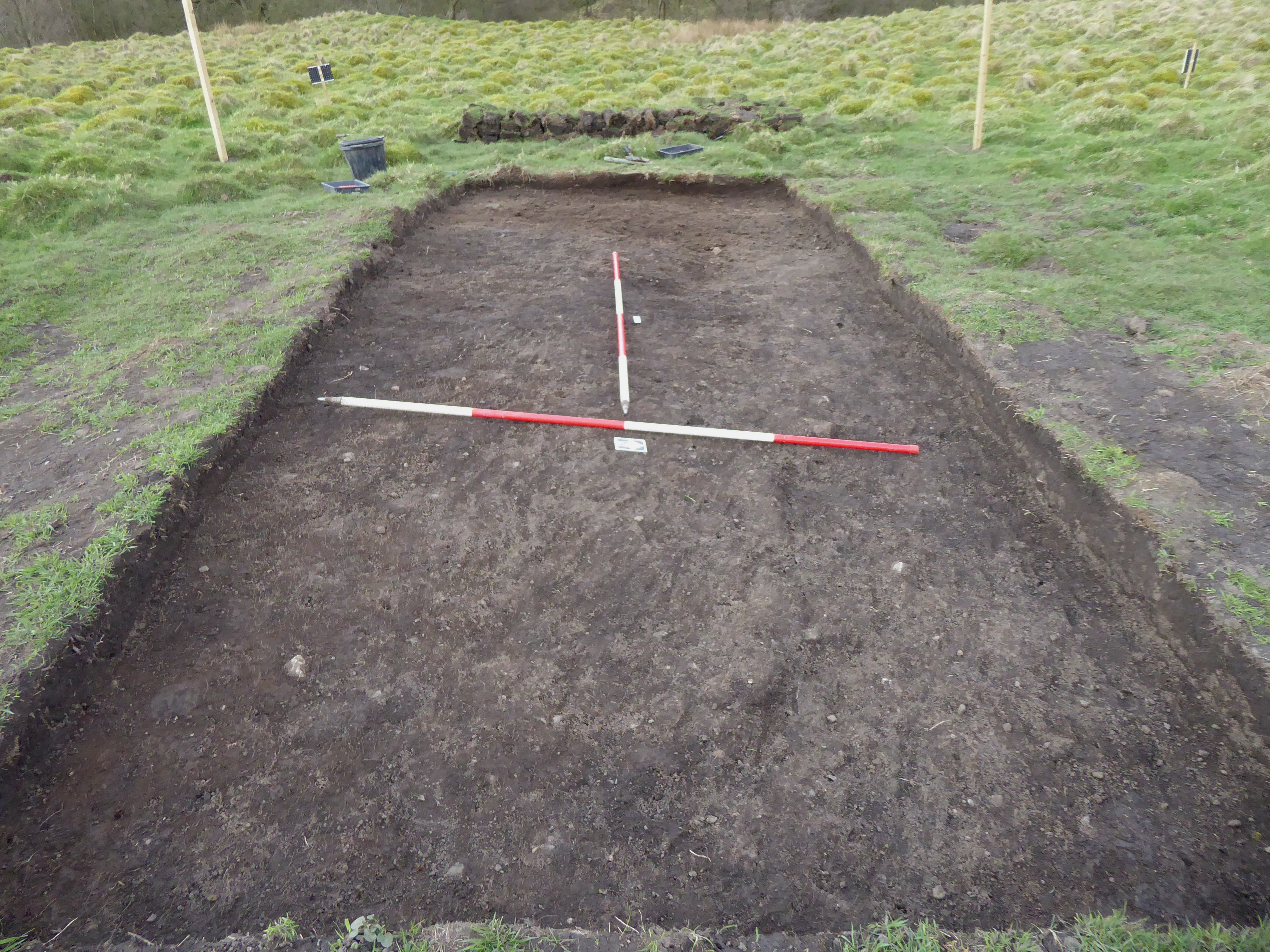
Photo 2
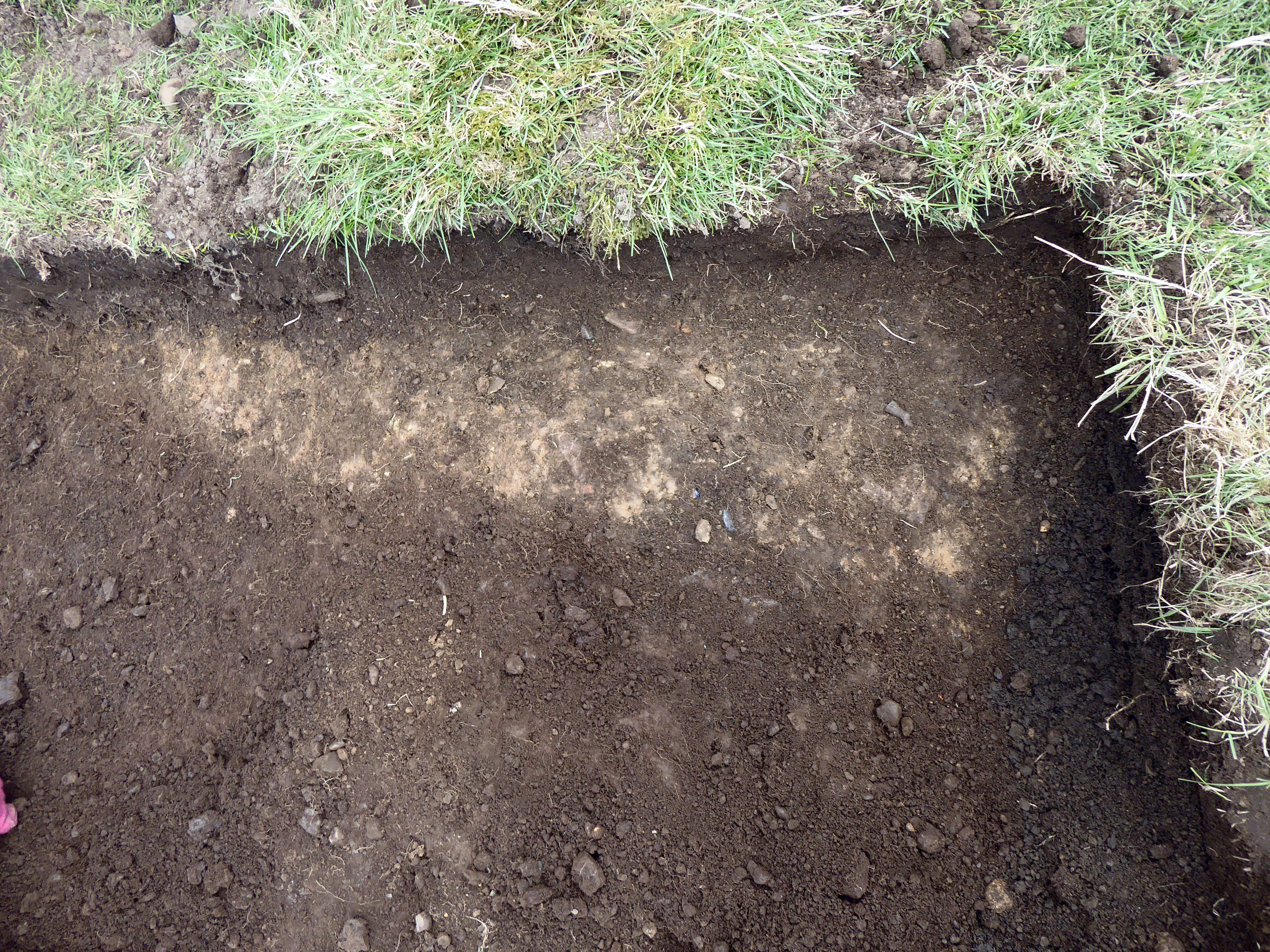
Photo 3
Weather was warm with sunny periods, perfect for digging.
Trench 1 (7 metres x 5 metres, orientated north/south)
The trench team started on the north end of the trench on the eastern edge and started working towards the western edge. By the end of the day a lot of soil had been removed with unfortunately very little in the way of finds. Photo 1 and 2. There were a number of small pieces of charcoal together with pieces of slag, but very little in the way of pottery sherds of any era. There was one very small piece of stone with a dark glaze on one face which caused some discussion as to how the glaze came to be on stone. Thoughts on this conundrum are ongoing.
Trench 2 (6 metres x 2.5 metres, orientated west/east)
Work was ongoing in three sections of this trench: the south west corner where the section of clay had been revealed at the last dig, excavation from the south east corner in a westerly direction and excavation along the north side.
Excavation of the clay from the south west corner revealed the surface of the continuation of the track way found in the bloomery trench during last year’s dig. At sometime in the late 18th / early 19th century the depression where the track way runs was filled in with clay and soil. Included in this filling were a number of pottery sherds and a nice clay pipe, the stem of which was broken. Photos 3 and 4.
During excavation from the south east corner a deposit of slag was revealed. Work is currently ongoing to establish the boundaries of this deposit and to try and ascertain whether it is part of a possible bloomery or just a deposit. Photo 5
The excavation along the north side of the trench produced the only medieval find of the day, a small pottery sherd. From its worn condition, dull instead of sharp edges, it was apparent that it had been moved around a lot and was probably part of some backfill. Never the less a good find for the day. Photo 6
Trench 3
This new trench is ‘L’ shaped; the shorter section lies between trenches 1 and 2 running north to south, with the longer section running east to west from the northern end of the first section.
The de-turfing operation was carried out in a very short space of time, a credit to the team working on this trench.
The laborious task of removing the top soil is now ongoing. As the western arm of the trench goes downhill the amount of top soil in this area is greater than the eastern end which means it is going to take longer to remove. The fun of archaeology!
Photos 7 and 8

Photo 1
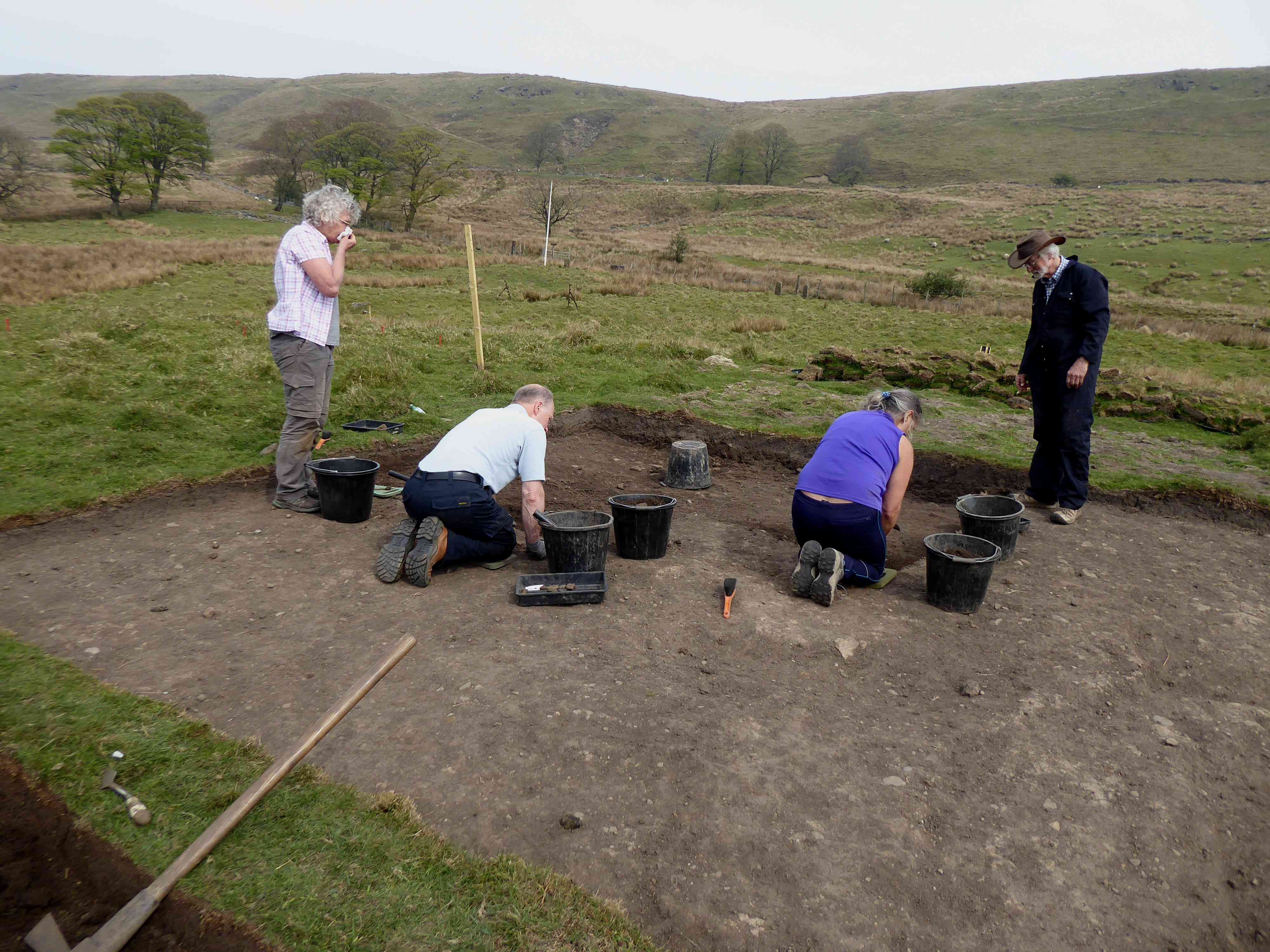
Photo 2

Photo 3

Photo 4

Photo 6

Photo 5

Photo 7

Photo 8
Weather: Very hot with an occasional cooling breeze.
Trench 1 (7 metres x 5 metres, orientated north/south)
As this trench had been exposed to the elements the compacted ground cleared of top soil had become very dried out and hard. One of the team persevered throughout the morning trying to trowel the ground with little success. The decision was taken to abandon work on this trench until a later date when heavier equipment can be utilised. Photo 1.
Trench 2 (6 metres x 2.5 metres, orientated west/east)
The east section of the trench consists of a fairly dense charcoal layer, giving a dark colour to the soil, this charcoal layer gradually peters out about a third of the way down the trench towards the west. Photo 2
The slag concentration, which was uncovered on Thursday the 18th April, was removed as it only consisted of loose pieces of slag and did not form an item of archaeological interest. The surface under the slag had been subjected to a high degree of heat, and forms a very compact layer. Investigation into the extent of this layer will continue at the next dig. Photo 3.
Excavation continued on the track way in the south west corner of the trench. The trench was extended in a southerly direction by a cut approx. 1 metre wide by 3 metres long. This excavation revealed that the full track way was approx. 3 metres wide, evident from the very compacted clay surface. It also revealed that the section excavated on Thursday 18th April would have been more heavily utilised as it is deeper than the section excavated today. Photo 4. A selection of early 19th century pottery sherds were recovered from the newly excavated section. Photo 5.
Trench 3 (L shaped)
Excavation of the short leg of this trench has revealed an interesting formation of stones forming a partial circular shape, with a line of stones lying just to the south and a random set of stones to the east. It is too early to define the actual purpose of the stones, however there is some speculation that it could be part of a bloomery. The bloomery unearthed last year lies a few metres to the south of this stone arrangement. Further excavation will be necessary in order to try and identify its actual purpose. Photo 6.
Excavations continued in two sections of the long leg of the trench, removing top soil. Unfortunately, these two areas were completely void of any finds other than minute pieces of late pottery and some small pieces of thin glass. Photo 7.
Trench 4 (2 metres x 2 metres)
This is a small trench which was partially de-turfed late on Thursday 18th April. It is located to the north of the north east corner of last year’s trench 2, where most of the larger pieces of medieval pottery were located. The purpose of the trench is to try and locate other possible pottery pieces. The gamble paid off as two sherds of medieval pottery were found. Hopefully more will be found as the trench is taken down to the depth where last year’s sherds were found. Photos 8 and 9.

Photo 1

Photo 2

Photo 3

Photo 5

Photo 4

Photo 9

Photo 7

Photo 8
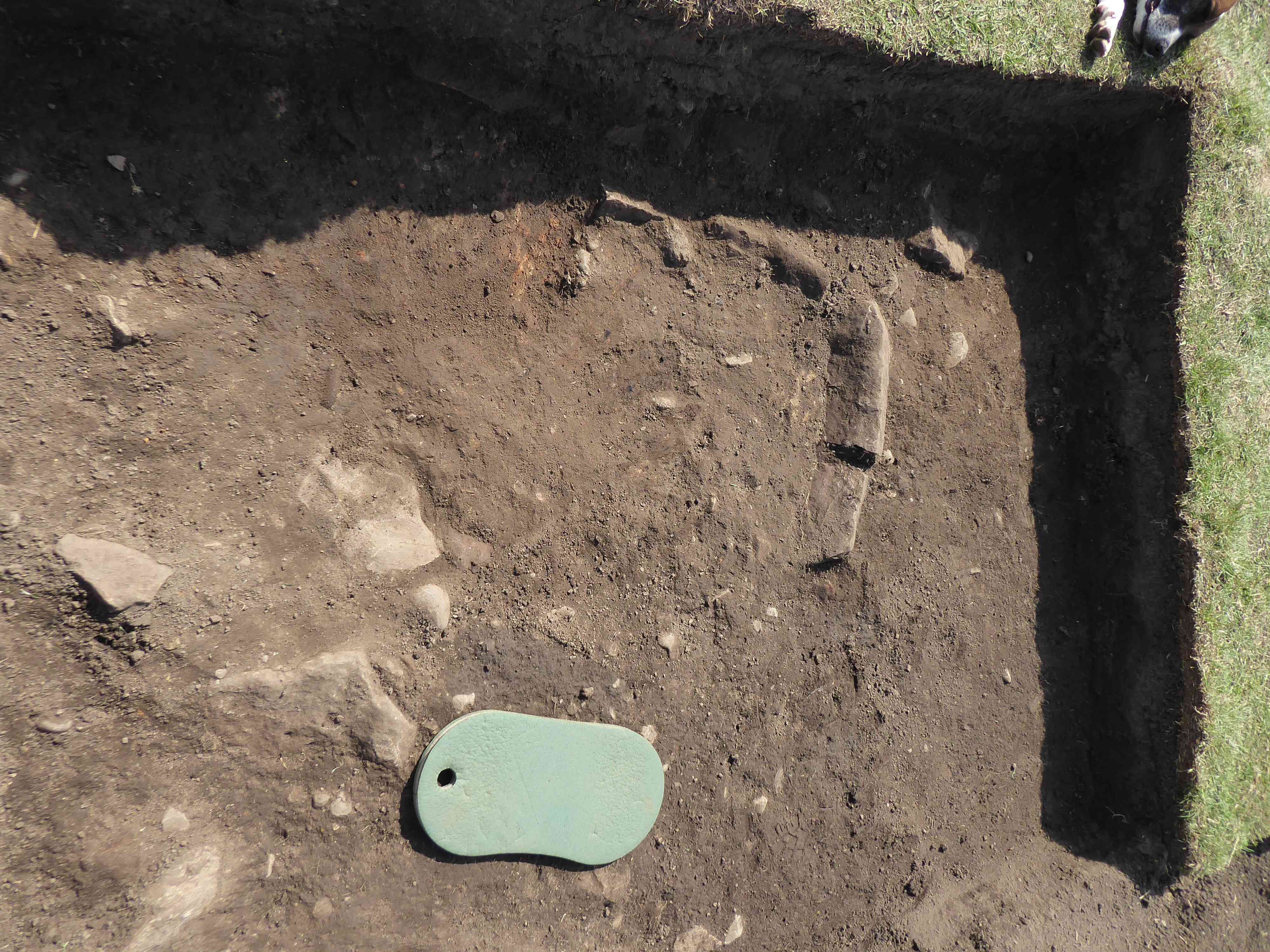
Photo 6
Weather: heavy rain, strong winds, low temperatures
Due to the adverse weather conditions, see above, today's dig was cancelled.
Weather - Bright, warm and breezy
Trench 1 -
No further work was carried out in trench 1 this weekend.
Trench 2 -
At the western end of the trench, cleaning work revealed a possible feature comprising a series of laid stones which have been partially covered with a clay deposit. This feature appears to end where the slag dump begins. Work will now need to continue in this area to find out the precise relationship between the two deposits and to see what lies beneath the clay deposit. - Photo 1
Meanwhile, at the eastern end of trench 2, the compact slag trackway was investigated further. A slot was dug through the trackway to reveal the complete section of this end of the trench. This will now need to be fully recorded before backfilling can commence. - Photo 2
Trench 3 -
Work continued on the removal of topsoil from this trench, and the careful investigation of the stone feature was started. Obviously a lot more work is going to be needed in this area. - Photo 3
Trench 4 -
Again, work on the topsoil removal continued with very little in the way of small finds to reward the efforts of the digging team. Work continues! - Photo 4

Photo 1

Photo 2

Photo 3

Photo 4
Weather - Heavy downpours of rain and hail in the morning, bright with sunny intervals in the afternoon
Trench 1 - Small investigation to find the next deposition layer revealed a charcoal, slag and cinder layer a couple of cm below the current excavation level. This now will enable us to use a heavier excavation technique as we know where the next level is to be found. This was important due to the compactness of the current layer, making trowelling hard work.
Trench 2 - Careful work further cleaning the feature found last excavation and defining the boundaries of the feature. This work revealed that the relationships between the deposits in trench 2 and also a possible animal burrow running through the clay feature. Further work needed to clarify this. Photo 1.
Trench 3 - Work continued on the long “arm” of the trench, removing more of the top soil. This produced several sherds of Holcombe Gritty Ware pottery. Work was also carried out on the short “arm” of the trench around the feature discovered last excavation. This work revealed a further feature to the North of the burnt stone feature. These features look very possibly like smithing areas associated with the furnace found last year. Work in this area will be ongoing to ascertain the function and form of these features. Photo 2.
Trench 4 - No further work this week.

Photo 1

Photo 2
PDF attached showing the Cinder Hill trench locations for the seasons 2018 and 2019.
Weather sunny warm to hot with a cool breeze.
Trench 1 (7 metres x 5 metres, orientated north/south)
There were two teams working in this trench today, one on the northeast side and the second on the north west side.
The area on the north east side had already been cleared of top soil so it was a case of scraping down to the next context. This layer had been open to the elements and, as a consequence, was compacted and difficult to work, but good progress was made none the less. There were only a couple of finds, a largish sherd of course medieval gritty ware and a smaller sherd of later pottery. Photos 1 and 2
The area on the north west side of the trench had a greater depth of topsoil, so it was possible to work on the area utilising mattocks to speed the trench excavation up. The only find of any significance was an out of context single large flat stone which has been subjected to a considerable amount of heat. At the moment it is impossible to ascertain whether this stone forms a part of a structure or whether it is a random deposit. Hopefully additional stones will be revealed as excavations continue in a southerly direction. Other stones have been excavated in trenches 2 and 3 which may form some association with this stone. By the end of Sunday we may have the answer.
Trench 2 (6 metres x 2.5 metres, orientated west/east)
The main area of attention today was on the deposit of clay in the south east section of the trench. There is a spiral cut out in the clay going around the perimeter of three sides of a large flat stone. Outside of the spiral cut is a rough semicircle of some 6 to 8 what appear to be stake holes. The holes are not very deep and contained a dark soil deposit, but no evidence of any remains of wooden stakes still in the holes. The significance of the spiral cut and holes in the clay are open to conjecture and unlikely to be resolved. That does not, however, stop a number of theories being put forward; some sensible and some not so sensible. Photo 5
The clay extends in a northerly direction. This section to be investigated at the next dig.
Trench 3 (L shaped)
Excavations concentrated on the north/south running section of this trench where there are two deposits of stones. Today work was carried out on the eastern stone deposit. After excavating the stones it appears to be a random deposit. In the centre of the deposit, however, there was a clear area which held a small sherd of course medieval gritty ware, similar in construction to the piece found in trench 1. The second deposit of stones, which has a definite shape to it and may be a smithy hearth, will be excavated over the weekend. Photos 6 and 7
Trench 4 (2 metres x 2 metres)
No work was carried out on this trench today.
Stones in trenches 1, 2 and 3.
The flat stone in trench one, the two stone deposits in trench 3 and the flat stone in trench 2 are all fairly well aligned on a straight line on a SW – NE axis. Is this designed this way or is it purely coincidental; who knows? We may, however, be able to reach some decision by the end of the dig on Sunday.

Cinder Hill Trench Plan

Photo 1

Photo 2

Photo 3

Photo 4

Photo 5
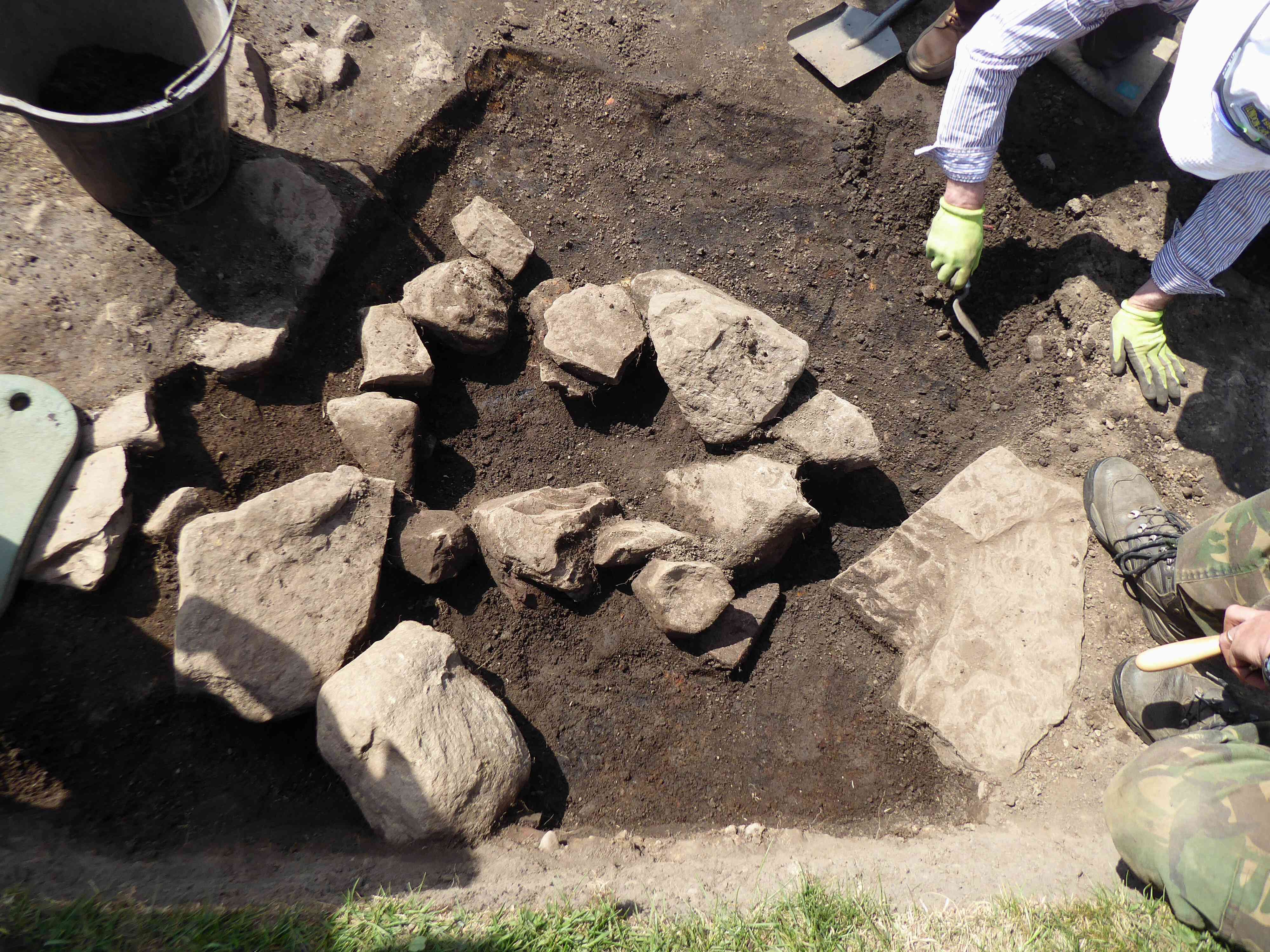
Photo 6
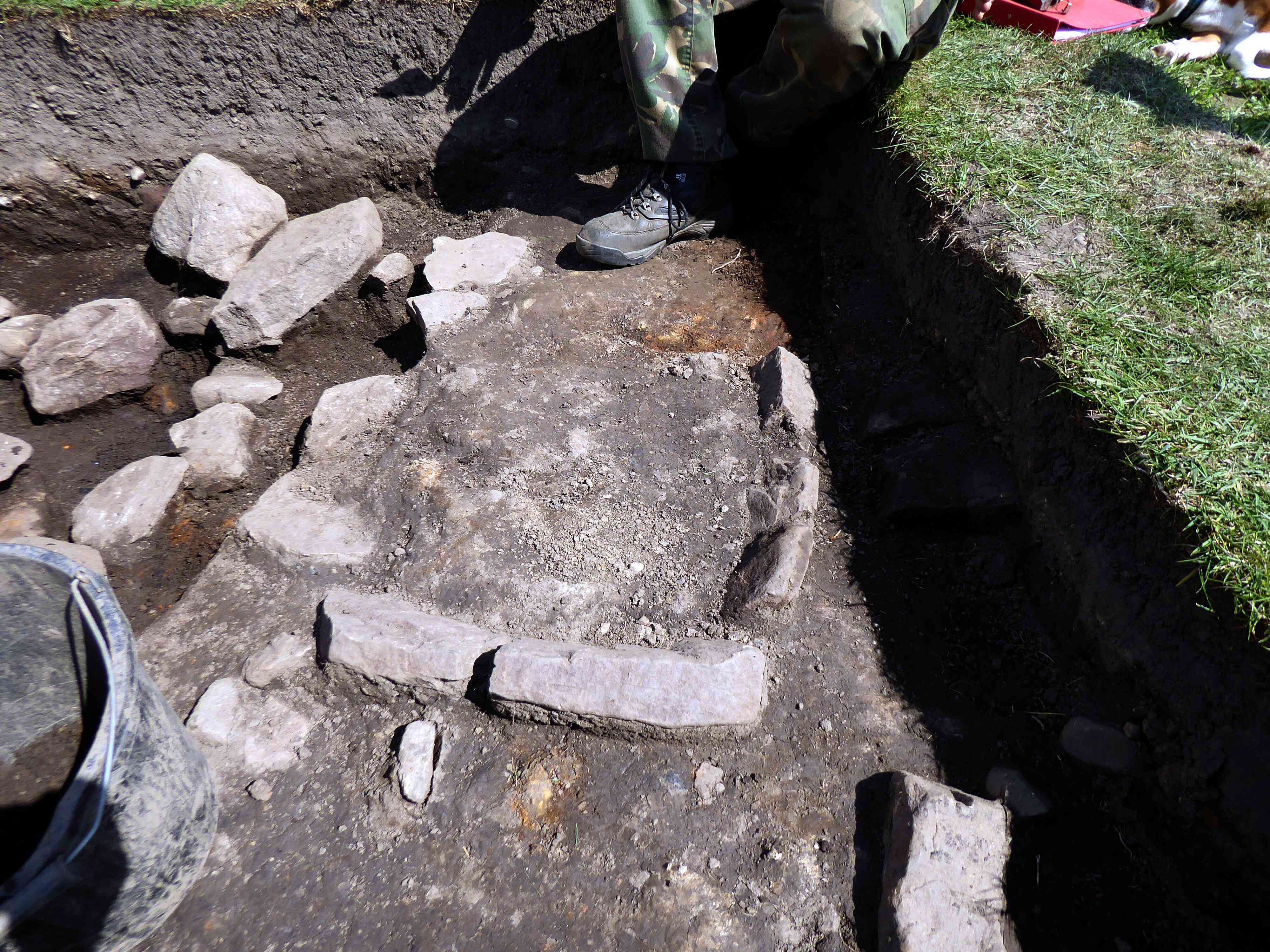
photo 7
Weather mainly overcast, cool and dry but sunny periods.
Trench 1
Work continued removing the topsoil from the trench to reach the first level of interest. As this trench is large removal of the topsoil, it is taking some time. Few finds other than a couple of sherds of mediæval pottery and a sherd of 17C pottery were recovered. An item of interest uncovered in the north east quadrant is a layer of clay, extending just into the trench from trench 3, in the immediate vicinity of the flat stone unearthed on 16th May. This clay is on the same level as the clay in trench 3 which covered the random deposit of stones. Photos 1, 2 & 3
Trench 2
After the flat stone and the associated holes in the clay surrounding it were recorded no further work was carried out in this trench. There was, however, quite a lot of discussion as to the purpose of the flat stone and the stake holes. Photo 4
Trench 3
A lot of work was carried out in this trench today.
In the north/south running section: clearance of soil from around the structured stone arrangement continued. Levels were taken of the stones in the unstructured collection of stones.The arrangement was recorded and drawn, then the stones were lifted, and the revealed area cleared of loose soil. (It was interesting to note that several of the removed stones had been subject to a degree of heat sufficient to cause the stones to take on a reddish hue). Further topsoil was removed from the northern end of this section, taking the level down to the charcoal level. Photos 5 & 6
In the west/east running section, work continued taking the surface down to the charcoal level extending from the north/south section of the trench. The amount of charcoal in this section was greater than the amount in the other section. Two largish pieces of charcoal were lifted and stored in kitchen foil for possible carbon dating. The amount of charcoal decreases rapidly towards the west end of the trench. Photo 7
With reference to the small section of clay found in trench 1, it is possible the structured stone arrangement in trench 3 is a smithy hearth and if the flat stone in trench 1 was used for hammering the impurities out of the bloom, the black smith would have walked between the two causing a depression. This depression could have then been filled in with the stones etc. and then capped with the clay which extends into trench 1 to achieve a level surface.
Trench 4
The team in this trench continued to remove the topsoil which, having been open to the elements, had become very hard. Perseverance paid off as they were able to unearth two sherds of medieval pottery, one small and one fairly large from two different vessels. They also uncovered a section of very red substance, coloured by being exposed to a sustained heat source. Further excavation is necessary to ascertain the composition of the red material. It is probably stone but it is very fragile and flakes easily. It is interesting to note that this reddened layer was not seen in the 2018 trench 2 which is immediately to the south of this trench. Photos 8 & 9

Cinder Hill Trench Plan

Photo 1

Photo 2

Photo 3

Photo 4

Photo 5

Photo 6

Photo 7

Photo 8
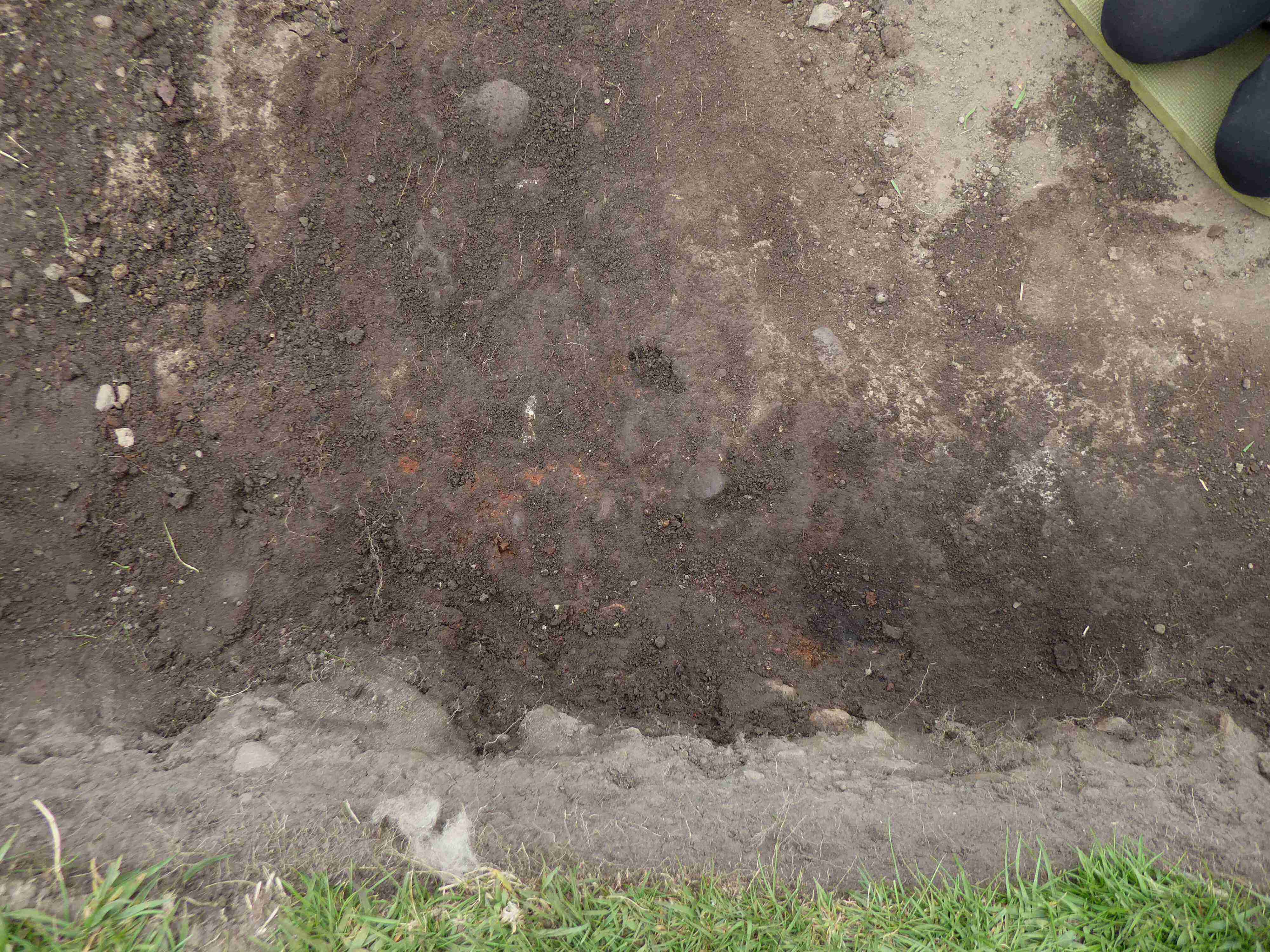
Photo 9
Weather: Very much the same as Saturday, mainly overcast, cool and dry with sunny periods.
Trench 1
Removal of the topsoil from this trench is still ongoing. The team were able to make good progress and are now about three quarters complete. A number of late sherds of pottery were recovered together with pieces of broken pipes, mainly the stems. Towards the end of the day areas of small reddish orange iron deposits were uncovered, these appear to be hammerscale as it is readily attracted to a magnet. Hammerscale is the flaky or spheroidal by-product of iron forging. On a site such as Cinder Hill it would be the result of the red hot iron bloom being hammered to remove impurities prior to being shipped off to a blacksmith. The hammering causes small particles of slag and iron, hammerscale, to be expelled from the bloom. Photos 1,2 and 3.
Trench 2
The surfaces of the clay around the flat stone were cleaned and recorded. The channel around the stone and the holes are now thought to be the work of Talpa europaea, i.e. the English mole. Mole activity has been found in other areas of the dig and the sizes of these holes roughly correspond to those in the other locations. It is just the unusual arrangement of the holes which gave rise to various theories. The north section of the clay layer was removed, which proved to be very shallow before the natural orange substrate was reached. Mole activity aside, the purpose of the clay packed around the stone is unknown. Photo 4.
Trench 3
The area around the bloomery forge arrangement was cleaned, photographed and levels taken before the arrangement was recorded. The infilled centre of the stone structure was divided in half with the intention of removing the infill of the eastern half to allow the different cross section levels of infill to be observed and recorded. It was interesting to note the clay on the eastern side slopes into the forge, which may indicate a repair was carried out at some time. While investigating the north side of the structure, Neil unearthed some very unusual pieces of slag. The main interest is their form and the fact that portions are hollow, similar to volcanic lava tubes but on a very small scale. Photos 5, 6, 7 and 8.
Work continued removing topsoil from the west end of the trench. The charcoal layer running from the east end towards the west end petered out towards the end of the trench giving way to the orangy natural surface also found in trench 2. No finds of any significance were unearthed from this area. Photo 9
Trench 4
No work was carried out on this trench.

Cinder Hill Trench Plan

Photo 1

Photo 2

Photo 3

Photo 4

Photo 5

Photo 6

Photo 7

Photo 8
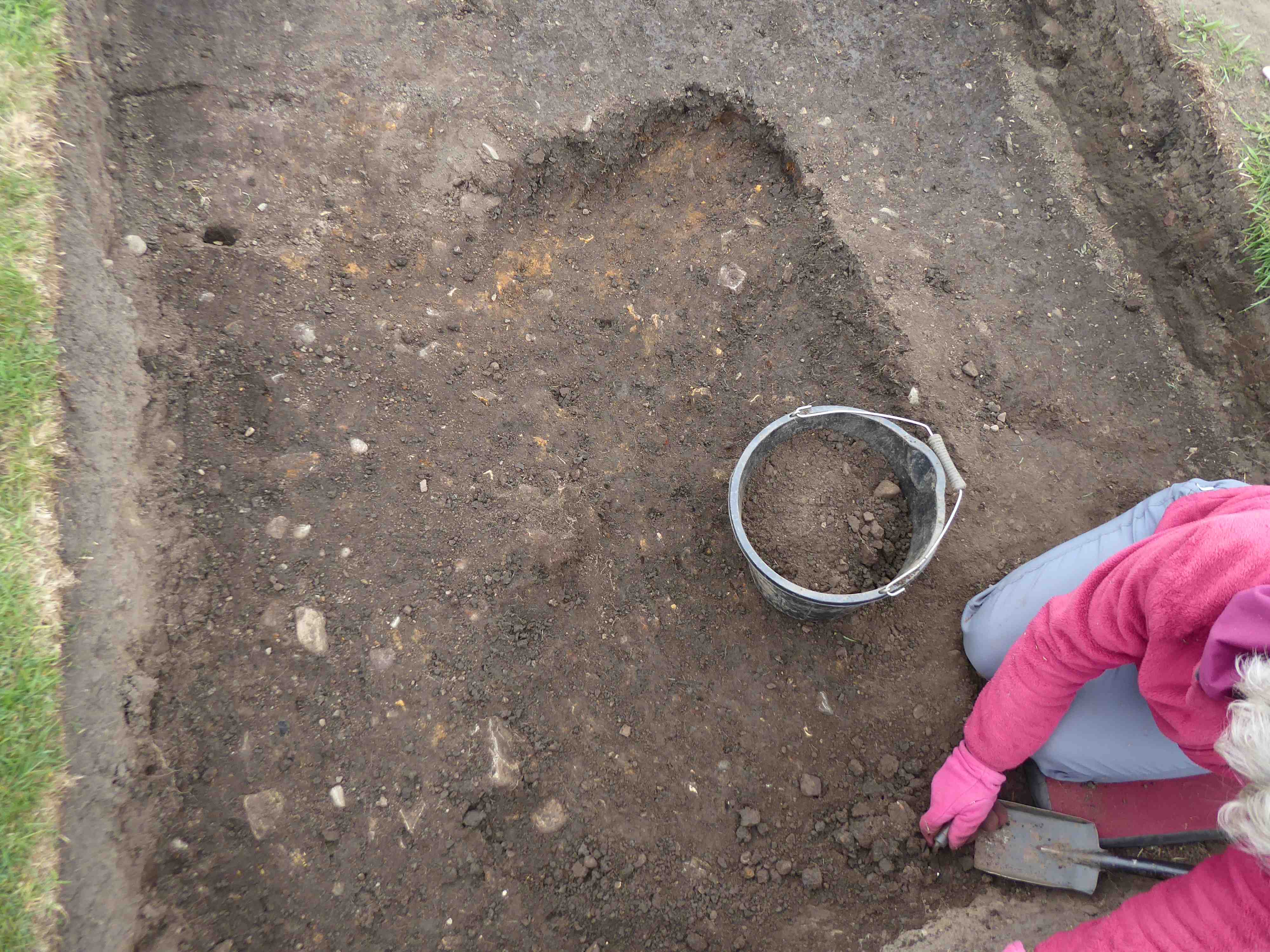
Photo 9
Weather: Overcast, light showers, cold wind.
Trench 1
Work continued clearing the topsoil from the remainder of the trench. Although a lot of soil was removed only a few finds were recovered, the main one being a small sherd of mediæval pottery and a couple of pieces of late 18 century pottery. The level was taken down to the white clay layer which appears to have been laid down in the working areas. This assumption has been reached from the fact that in some trenches, when the natural soil level is reached and where there is no white clay, there appears to have been no archaeological activity. If this white clay layer has only been laid in working areas, then its purpose has yet to be determined. Photos 1 and 2
Trench 2
After recording and taking levels of the flat stone surrounded by clay in which the moles had been at work, leaving their holes, the work on this structure was deemed to be completed. Photo 3. Further work continued along the north side of the trench taking the level down to the natural orange clay. Interestingly no layer of white clay was found in this area, Photo 4. Disappointingly no finds of any description were unearthed in this section of the trench. Work will continue in this trench at the next weekend dig before consideration is given to closing it down.
Trench 3
Work continued removing the eastern half of the spoil from the centre of the stone arrangement. Towards what appears to be the bottom of the stone arrangement a significant quantity of material with a high iron content was found. The high iron content was proven by the use of a magnet. The thinking now is that the aperture in the north section of the stone arrangement might be a tapping channel. A quantity of charcoal was removed from under one of the stones on this north side, a portion of which will be sent away for carbon 14 dating. There is an idea being mulled over that this may be a very early bowl furnace which was later modified and upgraded to a shaft furnace similar to the one uncovered last year in trench 1. The one main stumbling block to this theory is the lack of evidence of heating on the stones. If the arrangement were a furnace, the stones would be reddened by the heat; the higher and longer the heat the darker red the discoloration should be. Photos 5 and 6.

Cinder Hill Trench Plan

Photo 1
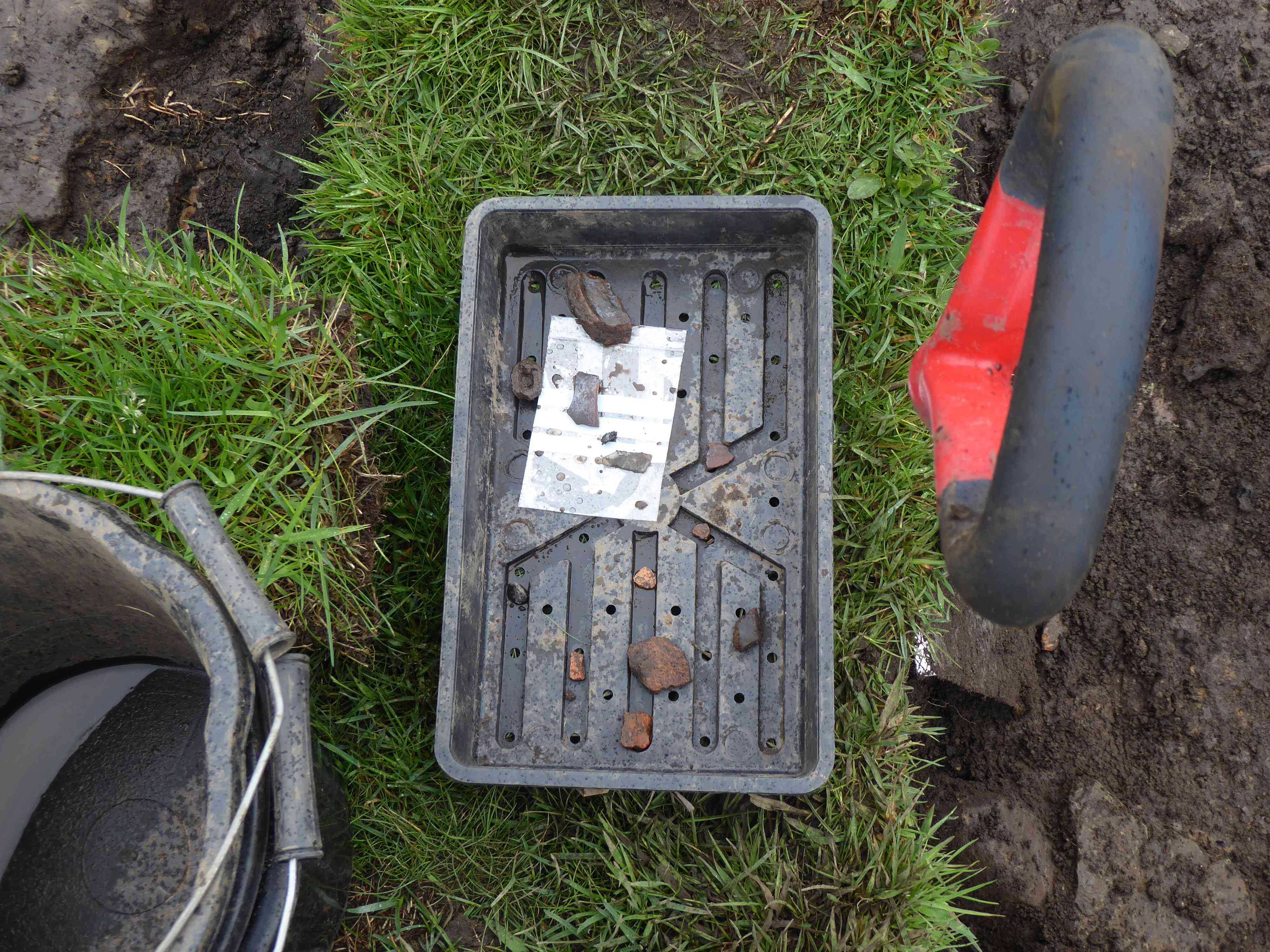
Photo 2

Photo 3

Photo 4

Photo 6

Photo 5
Dig Diary Saturday 22nd June 2019
Trench 1
Today the team successfully completed removing the remaining topsoil from the trench and in the process uncovered two pieces of mediæval pottery. On the southern end of the trench is a section of compacted slag which appears to form part of the pathway which runs through this section of the trench, and on the south west edge of the trench a number of flat stones. Some of these flat stones go under the 18in. partition between this year’s trench one and last year’s trench one where the bloomery was located. According to last year’s records the flat stones would appear to be very close to the Tuyere hole, where the bellows were inserted into the bloomery. It may be that the stones formed a platform for the bellows operator or else a platform for the bellows arrangement itself. In order to have a complete record of the arrangement, the immediate areas around the stones will have to be excavated. This will mean re opening the adjacent section of last year’s trench one.
Photos 1 & 2
Trench 2
Following the recording of a number of levels, work on this trench was completed. The flat stone section and the associated ‘mole holes’ were covered with plastic sheeting, and back filling of the trench commenced.
Trench 3
Attempts were made to clean the stone circle and clay section of this trench in order to carry out recordings, but unfortunately as the clay and soil are still very damp this action was not successful. It was decided to leave the trench open overnight in the hope that it may dry out before tomorrow’s dig.
Further excavations were carried out in the east west running section of the trench, the only item of interest uncovered was one piece of mediæval pottery; very disappointing for the team working all day on this section. A few more finds would have helped to make the day’s work more enjoyable and worthwhile.
Photos 3 & 4
Trench 4
In contrast to trench 3, eight sherds of mediæval pottery were recovered from the north west section of this trench, a very satisfactory day’s haul. If you look at the Cinder Hill Trench Plan photo, you will see that this trench is just to the north of last year’s trench 2, from which most of the year’s pottery sherds, some of which were very big, were recovered. Maybe this was the area where the refreshments were stored. Working with the bloomery would have been hot work and a lot of fluids would have been consumed, so there must have been a plentiful supply of beer and drinking vessels, many of which would have been broken and the sherds trampled into the soil.
Photo 5
Trench 5
Trench 5, smaller than originally planned, was marked out and de turfed. Work then commenced on removing the topsoil. A few finds were recovered but as can be expected from their position in the top soil the broken pipe stems and small pottery sherds were all of very late 18th and early 19th century era; probably from the time when the slag heaps were being cleared for use at Bottoms and for road use etc.
The main purpose of this trench is to ascertain the composition of the wall of the enclosure. If you look at the Cinder Hill Trench photo you will be able to make out the elliptical shape of the enclosure. Last years trench 3 was placed in the north west section of the enclosure wall, which revealed a dense section of slag. This year’s trench 5 is in the south east section of the enclosure wall, which, once uncovered, will determine this section’s construction material which should also be formed from slag.
Photo 6

Cinder Hill Trench Plan

Photo 1

Photo 2

Photo 3

Photo 4

Photo 5

Photo 6
Weather overcast with light breeze, no precipitation
Trench 1
A greater portion of the day was taken up by cleaning the western half of the trench to get a clearer view of the context in this part of the trench. The cleaning subsequently enhanced a feature just to the west of the anvil stone, running towards the south but, more importantly, also westwards towards trench three under the earth separation bulwark. The circular stone arrangement in trench three has a north facing opening and an associated depression in the soil running towards trench one. Heat discoloured material on the eastern face of trench one appears to carry through the earth bulwark into trench 2, which would tend to confirm the belief that the stone hearth arrangement in trench 3 is associated with the anvil stone in trench 1.
A depression in the ground towards the south west area of the trench was meticulously cleaned out and appears to be a post hole. In trench 2 a large flat stone was previously excavated, and this looked to be a stone on which to mount a post. It is possible that these two features had associated posts and formed part of a shelter wall between the two, as the middle of the round stone hearth feature in trench three sits in the middle and just to the North of a line drawn between these two features. It is hoped that a further two associated postholes will be discovered towards the north, to confirm that these two present features, together with the yet to be discovered post features formed some sort of a building or shelter.
Towards the end of the day cleaning work started on the east side of the trench. There is a quantity of charcoal residue staining extending from the eastern wall running towards the centre of the trench, thinning out and blending in with the grey clay as it carries through the trench. This black layer appears to be sitting on the orange natural soil. Last year’s trench two sits just to the east of this trench where there were very heavy concentrations of charcoal residue.
Photos 1, 2 and 3
Trench 2
This trench has been 90% backfilled, a credit to the team of two who did an amazing job to shift so much soil in one day.
Photo 4
Trench 3
Unfortunately, the ground did not dry out sufficiently overnight to allow the round stone hearth feature to be cleaned. A number of levels of various features in the trench were, however, recorded.
Photo 5
Trench 4
No work was carried out on this trench.
Trench 5
Work continued on the removal of the topsoil. A number of finds came out of the spoil, the usual collection of sherds of late pottery - tea cups, bowls, part of a teapot spout etc. as well as two finds which have proved difficult to identify. The most intriguing piece is a long thin piece of what appears to be stone, with a thin light brown layer encrusted on to it. Where the surface is worn or broken away the colour of the underlying material is bright blue. Further investigations will be necessary to try and identify this material.
The other interesting object was a small piece of material which has been glazed on the top and some of the sides. From its shape It does not look as if it comes from any piece of pottery.
As these objects have come from the topsoil they will not be all that old. It will be nice however to be able to identify these objects even though they are unlikely to be associated with the iron smelting era of the site.
Photos 6, 7 and 8.

Cinder Hill Trench Plan
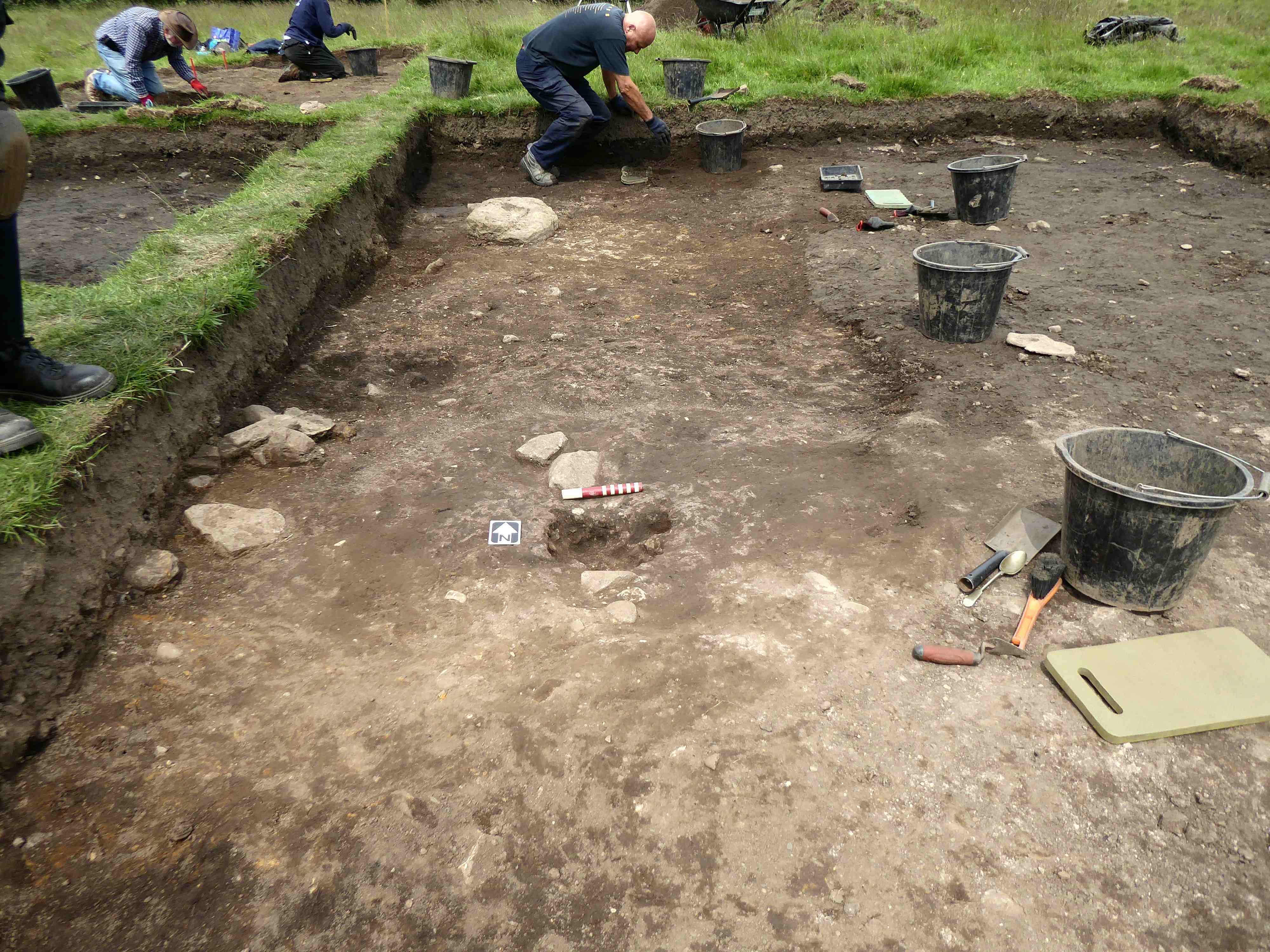
Photo1

Photo 2

Photo 3

Photo 4
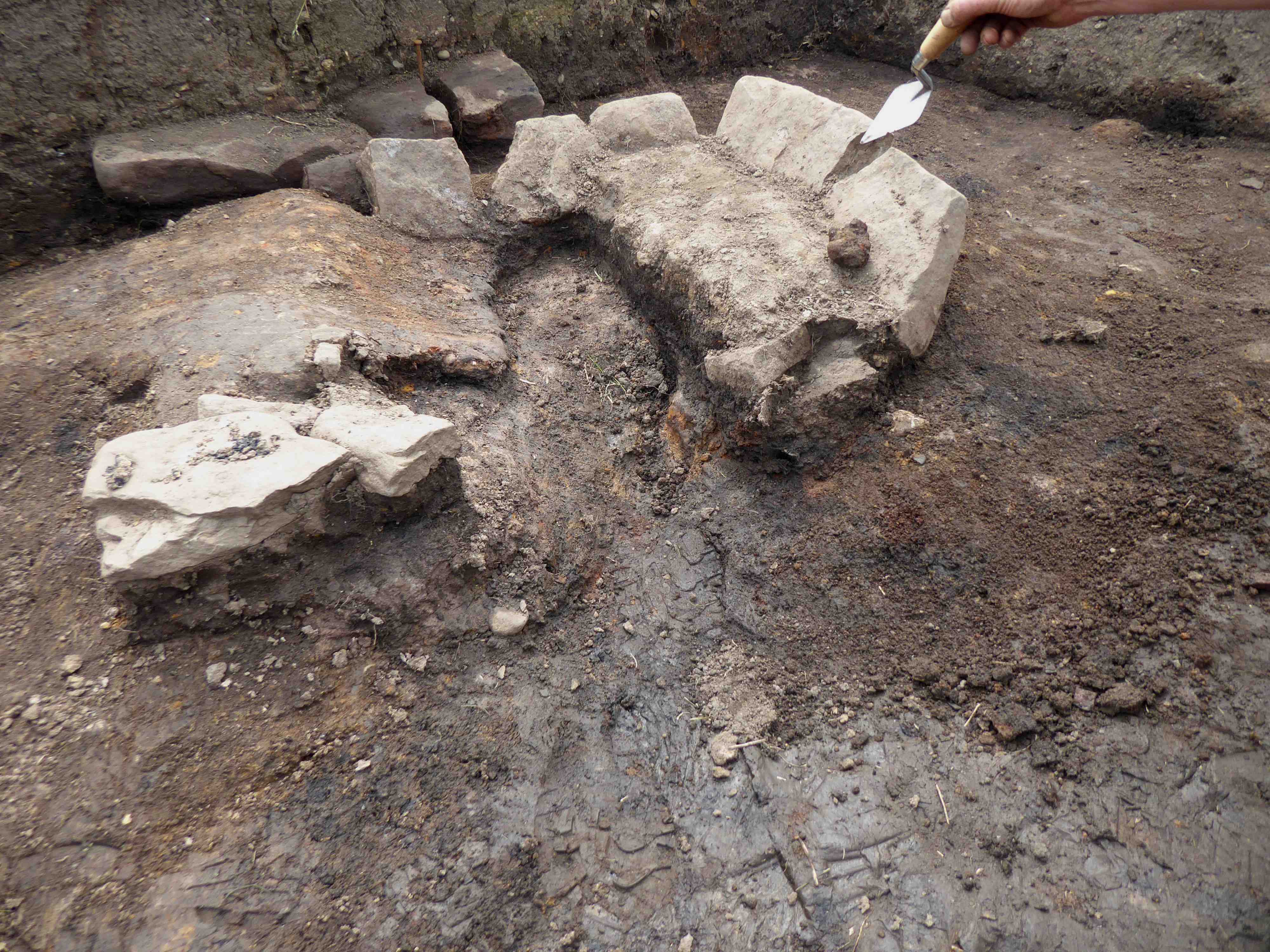
Photo 5
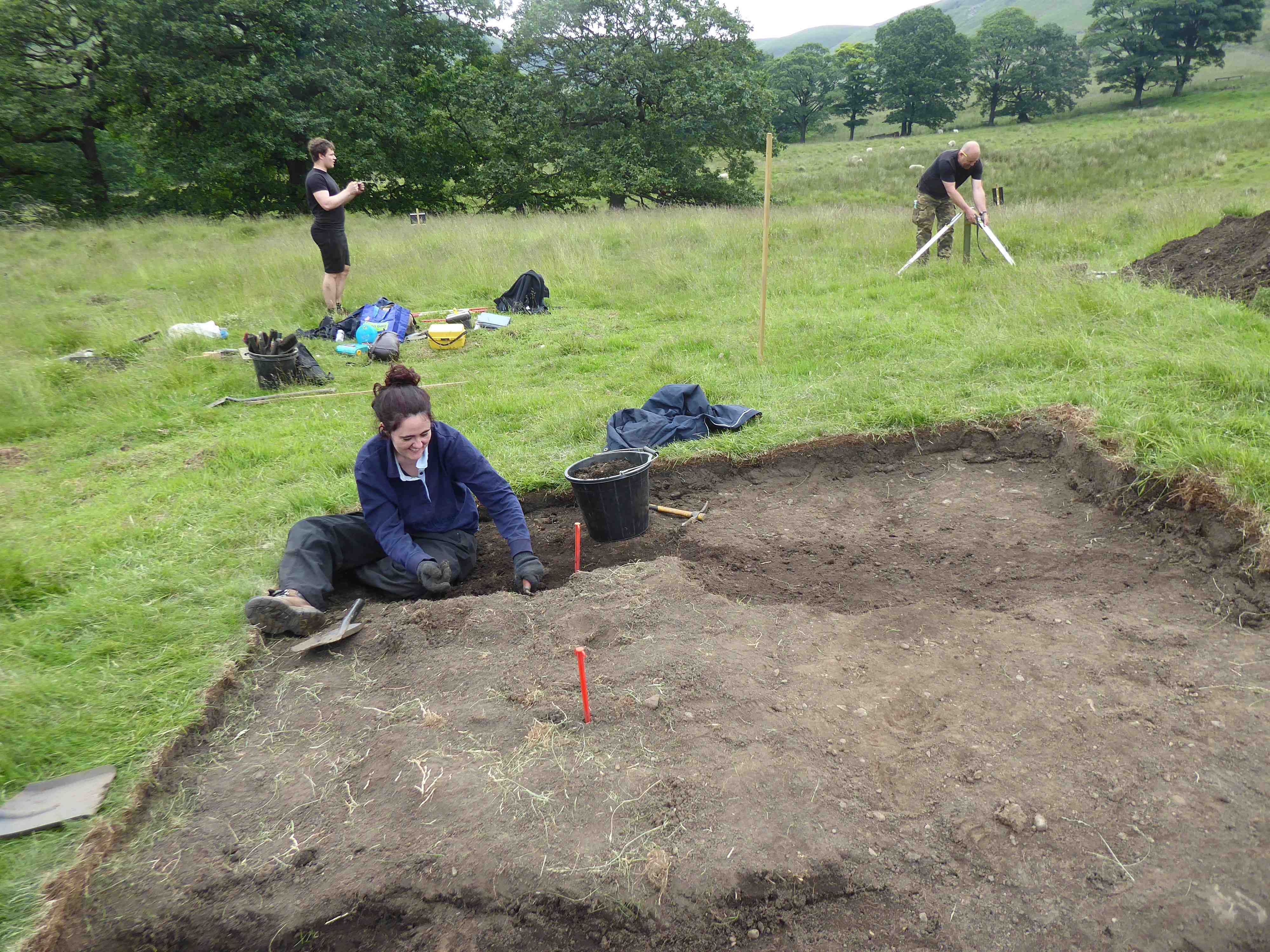
Photo 6

Photo 7

Photo 8
Weather: Sunny with cooling breeze.
Trench 1
Work continued cleaning the trench.
On the eastern side of the trench one of the team uncovered a small piece of knapped flint. There are signs that it was worked, so may have been used/intended as a scraping tool. As this item was recovered towards the bottom of the relatively shallow trench, it would not have been dropped in Neolithic times. How it came to be in that position will never be known; very interesting non the less.
Neil was recently looking at photos of the trench and thought he could see the faint indications of a semi-circular impression in the soil in the south west edge of the trench. This area was gently scraped clean, but nothing definite was found.
Towards the end of the day one of the team was cleaning around a flat stone which appeared to be imbedded in the ground at an angle on the western edge of the trench. Initially the size of the stone was unknown, so the decision was taken to excavate the western side of the stone. The stone turned out to be of a fair size and the hole it was buried in was surprisingly deep. When the infill had been completely removed, water started to seep into the bottom. The purpose of the stone is, at the moment, unknown. A few theories were discussed but as usual, as with a lot of items on a dig, nothing can be definitively proven. As this item was excavated at the end of the day no further work was carried out on it. The hole was packed with plastic sheeting and grass turfs placed around it to protect it from marauding sheep. An interesting observation was pointed out that in trench three, immediately to the west of the stone on the other side of an eighteen inch soil bulwark, there is heavy contamination of charcoal and the soil is stained black. There are no signs of this staining around the stone. It looks as if the bulwark will have to be removed to ascertain why this is the case.
Photos 1,2, 3 & 4
Trench 2
No continued back filling work was carried out on this trench.
Trench 3
Neil spent a happy couple of hours recording the stone structure together with the various context uncovered where a section of the infill in the centre of the structure had been removed. Unfortunately the charcoal stained ground immediately to the north of the structure was still very damp, preventing any cleaning taking place. There is a possibility that the ground in this area is covering a fairly deep depression, which could possibly be a pit into which the tapped slag would run.
Photos 5 & 6
Trench 4
No work was carried out on this trench to day
Trench 5
Work continued removing the topsoil. A small sherd of mediæval pottery was found, but as this was in the top soil it does not reflect the correct context where it would normally be found. A late clay pipe was also unearthed. The stem was broken and a small piece of the bowl was missing, otherwise it was in fairly good condition.
When this trench was initially marked out on the previous Saturday, 22nd June, and before any de-turfing took place, three members of the dig walked over the area with a set of dowsing rods. Interestingly two areas in the same locations were identified by each member so the two spots were marked with pegs. As the trench has been excavated the only item which has been found in the vicinity of the two pegs is the blue stone which was found on the Sunday near to the northern peg. At the end of the dig covered by this report the ground was gone over with the dowsing rods and these two spots are still being registered by the crossing of the rods. It will be interesting to see if we ever do find anything, (a nice hoard of coins would be appreciated).
Photo 7

Cinder Hill Trench Layout

Photo 1

Photo 3

Photo 2

Photo 4

Photo 7

Photo 5

Photo 6
Weather: sunny spells with occasional light showers
Trench 1
Work concentrated on the bulwark between trench 1 and trench 3, mainly in the vicinity of the deep post hole with the large flat stone set at an angle in it. The purpose of the excavation was to try and confirm the purpose of the hole, which is assumed to be a post hole, and its relationship to trench 3 where a possible slag pit from the bowl furnace/hearth is in close proximity to the hole in trench 1. A number of flat stones were uncovered under the bulwark and appeared to be sitting on a section of baked soil. Once the stones were photographed, they were removed and the loose soil in the hole under the stones was also removed. There is some doubt now as to whether this hole is in fact a post hole as its shape vaguely resembles a three leafed clover. The north, east and south faces of the hole are into the natural clay while the west face appears to consist mainly of silt; this section still needs further excavation through into trench 3.
A number of pottery sherds were recovered from the bulwark the majority of which were of a later manufacture, no medieval pottery was uncovered.
Photos 1, 2 and 3
Trench 3
Work in this trench just consisted of some excavation but mainly cleaning around the circular stone feature. Additional work was carried out in the west/east running section in an attempt to ascertain the extent of the charcoal deposits.
Photo 4
Trench 4
Work was carried out during the morning session to remove more of the topsoil. No finds were recorded.
Photo 5
Trench 5
The team of two spent the day heroically engaged in removing the topsoil of which this trench seems to have an abundance. This raises the interesting question as to why does this trench have a deeper layer of topsoil than any of the other trenches? Towards the end of the day a layer of charcoal was reached which would tend to suggest that some form of burning took place uphill towards the east end of the trench resulting in the charcoal being deposited downhill. In comparison, similar deposits of charcoal in trench 3 are closer to the surface. Unfortunately the number of finds in the trench was abysmal, one small sherd of pottery and an unusual shaped stone with marking on one side, which will be examined in due course. The markings are just random lines, they do not form any pattern or lettering.
Photos 6 & 7

Photo 1

Photo 2

Photo 3

Photo 4

Photo 5
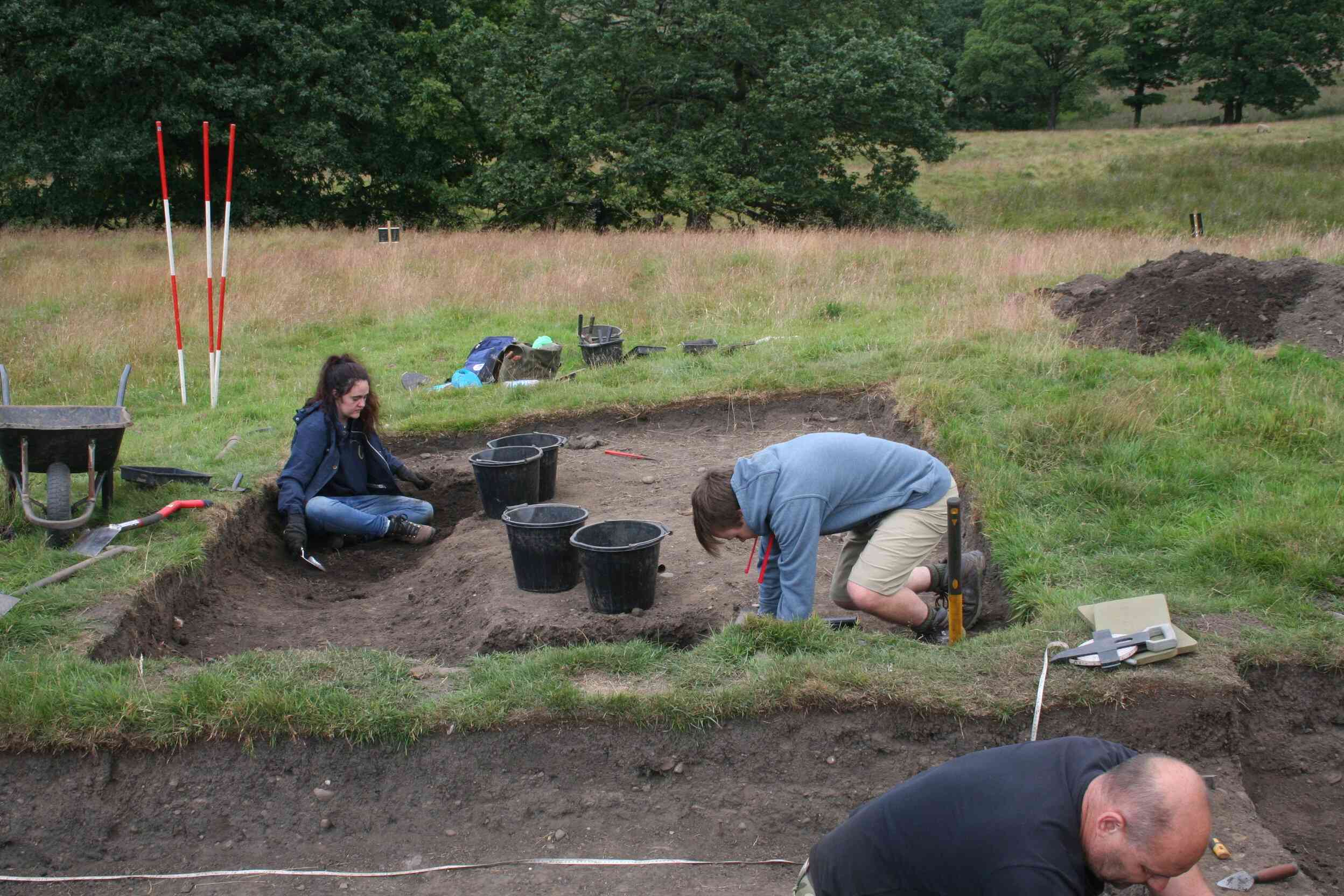
Photo 6

Photo 7
Dig Report Thursday 1st August 2019
Please note the digs scheduled for Saturday and Sunday 24th and 25th August have been cancelled. The next dig will be held on Thursday 29th August
Weather: mainly cloudy with sunny intervals, to begin with.
Due to the amount of rain which has fallen in the past few days all the trenches had to be bailed and sponged out before any work could commence.
Trench 1
Work was carried out in three areas in the trench.
The northern edge of the east/west running trackway situated against the southern edge of the trench was worked on, exposing the compacted layer of various sized stones. Photo 1. This trackway runs in a westerly direction through the edge of last year’s trench 1, and continues downhill towards Red Brook. There is a very strong possibility that this track was laid in order to carry slag down to Bottoms, as a large quantity of slag was excavated south east of the cottages and throughout various areas of the land running southwards from the cottages to Red Brook.
Exploratory work was carried out along the southwest edge of the trench removing the bulwark between trench 1 and last year’s trench 1. A number of stones were uncovered, but at this stage it is difficult to determine whether they are of any archaeological significance or just random stones. Photo 2
Cleaning also took place in a small area towards the centre of the trench, the only items found here were three very small fragments of stone, which give the appearance of having blue glazed areas on one side. Although a few similar examples have been recovered in the past, we are still not exactly certain of their origins. It is assumed they are fragments of a certain type of stone which has been heated to a high temperature, transforming it to this blue state. Photo 3
Trench 2
Some re turfing of the trench was carried out.
Trench 3
The main exercise of the day in this trench was to collect samples of the charcoal blackened earth which exists in the east west running section of the trench. The area was marked off into 20 equal squares and samples of earth from each square were packed into a marked plastic bag. Photo 4. Ultimately it is hoped these bags will be sent away for analysis, if the group can raise sufficient funds, to determine the amount of hammerscale in each bag. The distribution of the scale over the area could give an approximate position of where any bloom was worked with a hammer, generating the hammerscale.
Hammerscale, also written hammer scale, is a flaky or spheroidal byproduct of the iron forging process. Hammerscale is almost universally recovered from archaeological excavations in areas where iron ore was refined and forged. Wikipedia
Trench 4
Trench 4 aka the swimming pool. Needless to say, no work was carried out in this trench. Photo 5
Trench 5
Work continued removing the topsoil. Removing the topsoil in this trench has proved to be very slow and laborious. Photo 6
At approx. 14:30 hrs, rain was observed coming down the valley from the north. Although we tried frantically to pack up all the gear before the rain hit, we failed, and were treated to a good down pour so we called it a day.
Post Note to Dig report for Thursday 1st August 2019
Received the following from Ken Howarth a few days ago which I think you will find interesting. It is regarding the blue-green glassy stone fragments we have been digging up on site.
Ken, as well as being a member of HMHG, is associated with the DSWA, (Dry stone Walling Association) and has a keen interest in geology, and is called on to help local authorities for his expertise.
Hi Richard,
Just to add a bit of information on your recovery of the blue-green glassy slag. I have come across this at the Backbarrow iron works site near Ulverston. See link to photo. https://heritagephotoarchive.co.uk/p262682648/h7bb2dd67#h7bb2dd67(photo 7). Glassy structures are not just confined to iron smelting - surprisingly there is a strong similarity to some lavas.(eg obsidian). I asked a friend of mine Clive Boulter a retired professional geologist who has worked all over the world who knows a lot more about these things than I do, for comment, . His reply as follows: "Hi Ken - the glassy part is easy. It is ultra rapid cooling that doesn't allow crystal structure to form. There's plenty of glass in the Cumbrian slag and it mostly forms on the margins of the ladles/slag boxes but when the ladle/box is tipped and the bulk of the skull/pudding fractures the residual liquid can be injected between the fragments and chill rapidly to form networks of glass. The colour is presumably a function of trace quantities of various elements but it might be just light internally reflecting within the glass. I saw a striking set of colours on a spinifex textured bit of slag at Workington which probably was sulphides but these days I only have a hand lens so can't be sure."
I hope this helps! Keep up the good work, Ken
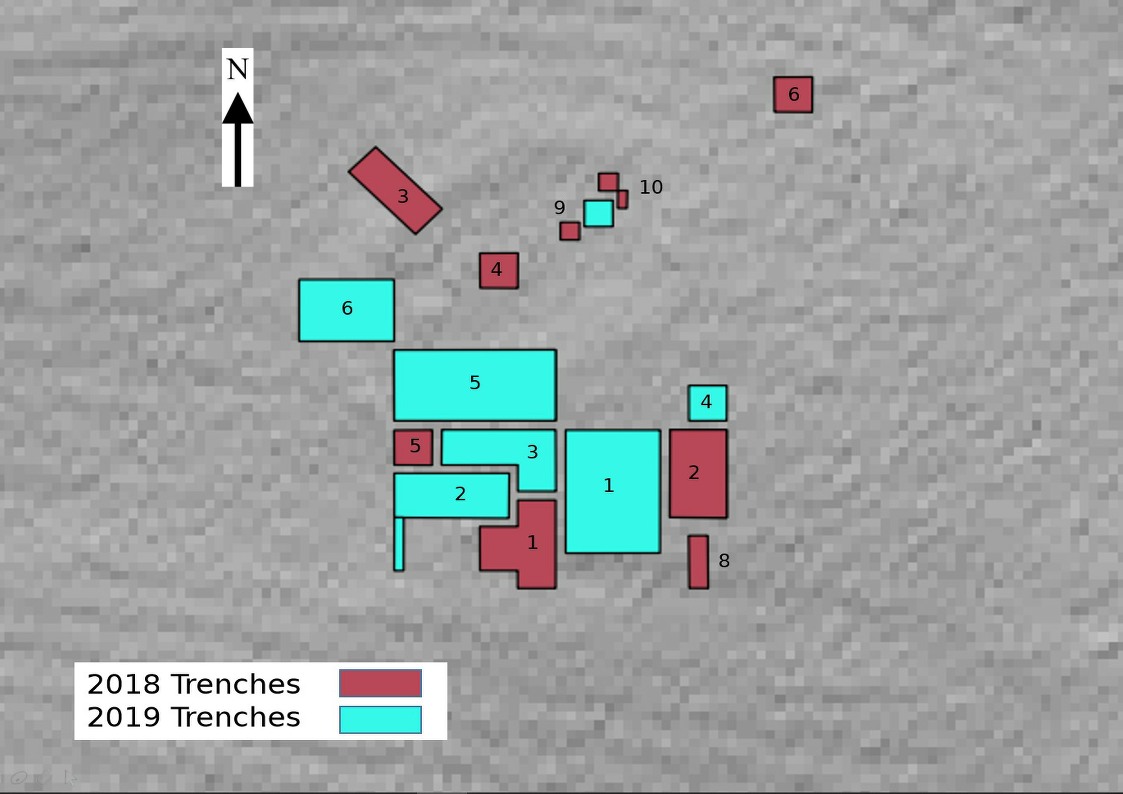
Cinder Hill Trench Plan

Photo 1

Photo 2

Photo 3

Photo 4

Photo 5

Photo 6

Photo 7
Weather: Overcast and cool
Trench 1
A number of levels were taken in the trench
The large ‘post hole’ was cleaned for photographing. Photo 1
The excavation of the trackway on the southern end of the trench was extended in a southerly direction to expose the extent of the trackway. This revealed another slight depression which could be a wheel rut similar to the rut some 2 ft to the north. Another interesting item appears to be a very compact darker infill, running roughly west to east, which could be a back filled drain. Photos 2 & 3. The backfilled drain can be seen on photo 3 as a faint dark strip running up the photo, and roughly the width of the measuring stick. This will have to be investigated at the next dig.
Trench 2
Previously closed down and back filled
Trench 3
The area around the hearth and a cross section of the hearth clay infill cut were cleaned and photographed. Photo 4
More of the charcoal from the east west running section of this trench was bagged and tagged for investigation at a later date, for hammer scale concentrations. Photo 5
Trench 4
Work continued cleaning the trench. As it has not been worked on for some time it was a bit worse for wear. In the southern half of the trench a number of stones and slag pieces are being uncovered which may transcribe into some interesting archaeology; time will tell. The best items of archaeological interest to be uncovered were, however, in the west end of the trench - a large number of fine quality mediæval gritty ware sherds were recovered. These particular sherds appear to be of better manufactured quality than the Holcombe Orange and Holcombe Buff gritty ware sherds which were recovered from last year’s trench 2. Photos 6 & 7.
Trench 5
The final layers of top-soil were removed from the northeast section of the trench, to reach a charcoal layer which appears to extend from the west leg of trench 3 through to this trench. The amount of charcoal pieces in trench 3 and the charcoal blackened ground in both trenches would tend to indicate that these areas could have been utilised for charcoal storage. Photo 8
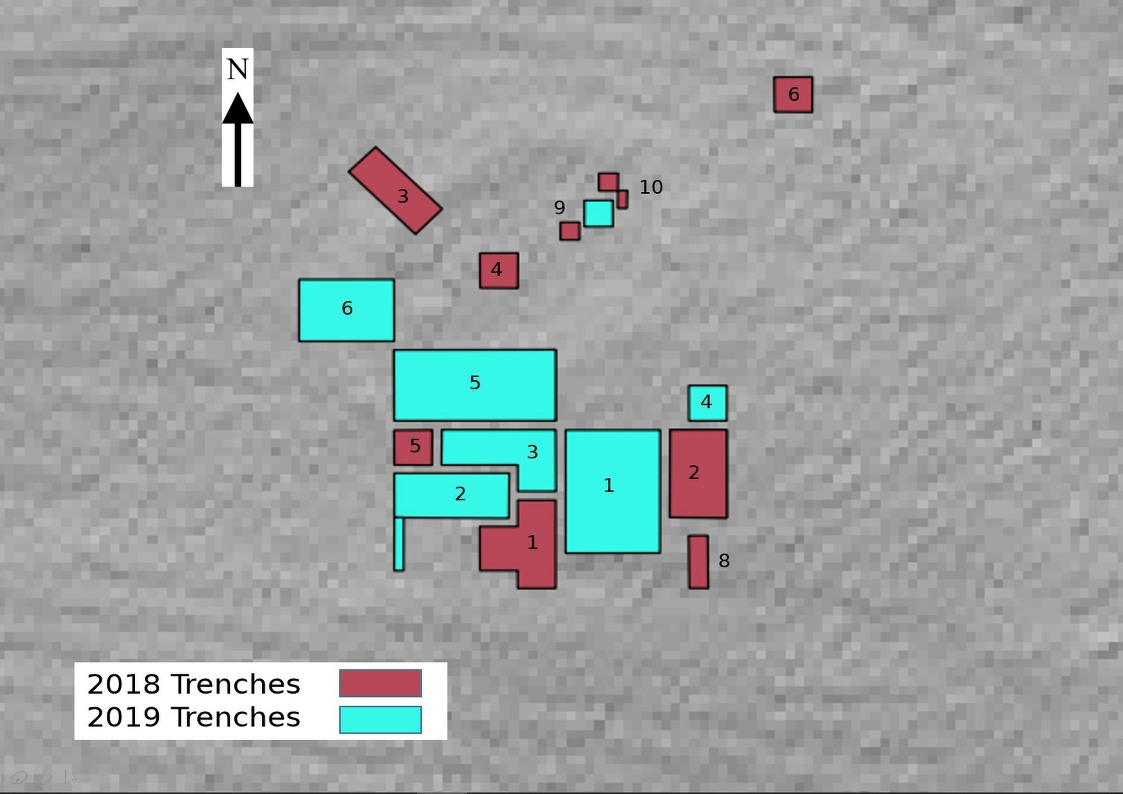
Cinder Hill Trench layout

Photo 1

Photo 2

Photo 3
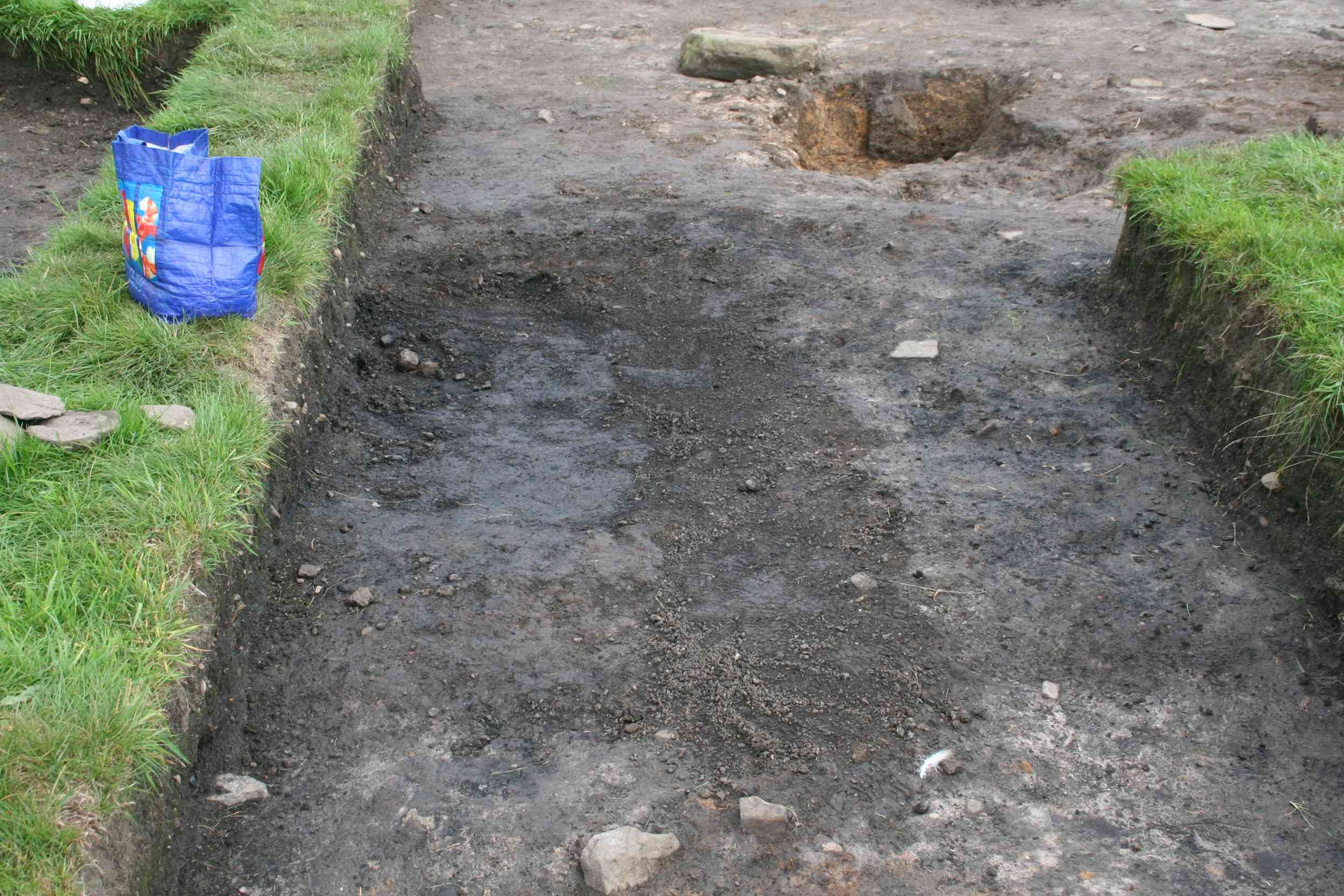
Photo 5

Photo 6
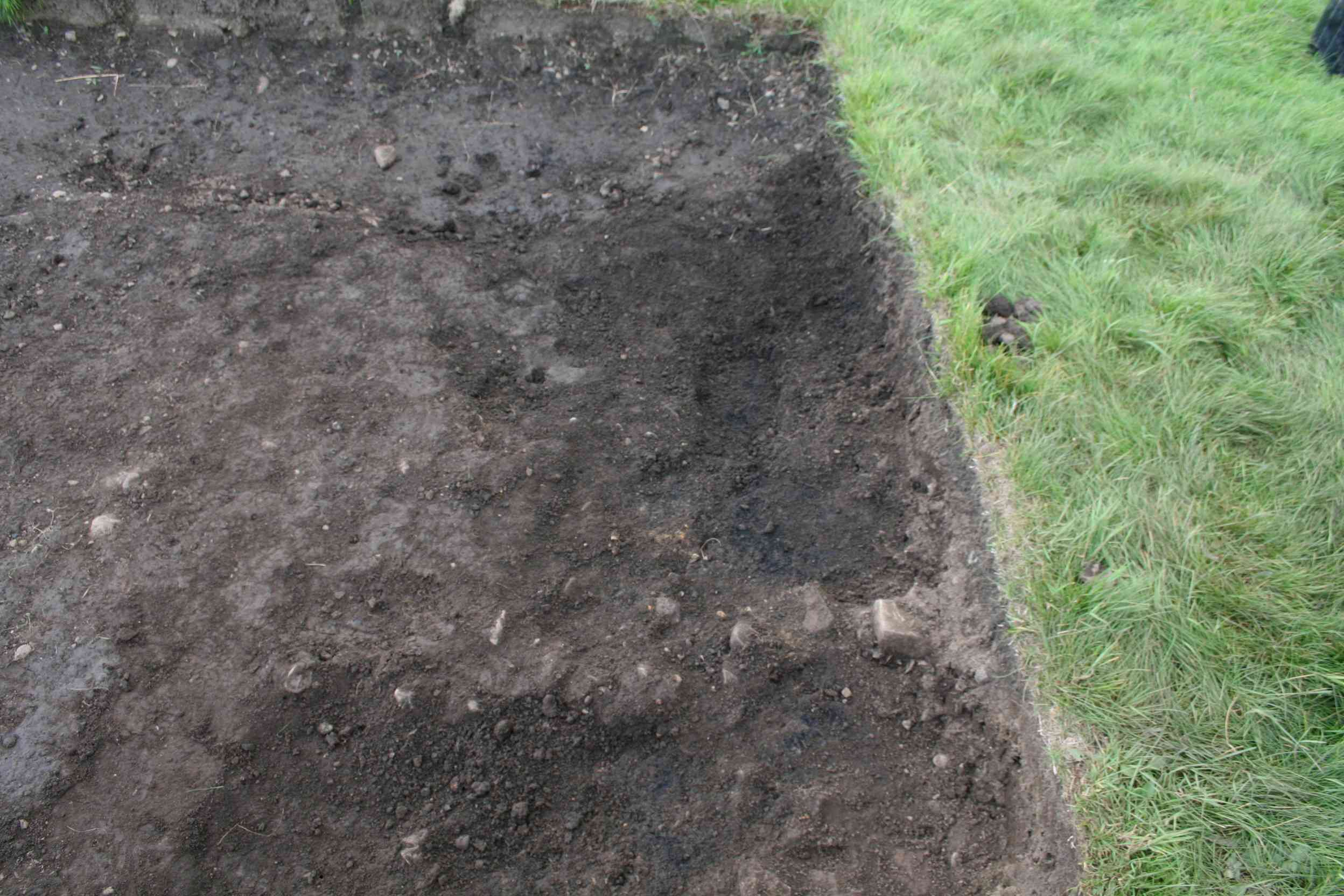
Photo 8

Photo 7

Photo 4
Weather: partly cloudy with heavy rain showers towards the end of the dig session.
Trench 1
Investigation carried out into the dark strip running approx. west to east on the southern section of the trench. This strip was uncovered during the last dig as it was thought to be a possible drain. At the end of the day it appeared to be a very shallow strip of darkened soil, with no substance to it at all. A couple of passes of the trowel removed all evidence of its existence. Its exact nature in relation to the compact pathway therefore remains unknown. Photo 1. A smaller section of the trench was excavated to try and ascertain the extent of the pathway; no evidence of any archaeology was discovered. Photo 2.
Trench 2
Closed down previously
Trench 3
The heavily charcoal darkened section was cleaned up and photographs taken. Photo 3. A section of the darkened soil was taken out to confirm the depth of the layer of the charcoal surface by revealing the white clay layer underneath. You will recall from previous dig reports that this white clay layer appears to have been laid down over most of the working areas, reason unknown. Photo 4. The areas around the stone hearth was cleaned up, Photo 5. You will notice that a number of the stones have the charcoal extending under them which indicates that the stones were laid after the white clay and charcoal residue were laid down.
Trench 4
During the last dig on the 29th August, photo 6 showed a short strip of orange coloured soil at the top of the picture, which is the southern face of the trench. This orange coloured strip was investigated further and revealed an extensive deposit of what is thought to be a combination of dust and small fragments of iron stone. This orange material was under a thin layer of slag. Due to the lack of any signs of heating of the white clay under the orange material it is unlikely that this area would have been utilised to roast the iron stone. It is more likely to have been be a storage area. You will notice some holes in the layer, this is though to be the result of our old friend Mr. Mole and not post holes. Photo 6
Trench 5
A lot of work goes on in this trench for very little reward. A large amount of soil has been removed, since the trench was opened, and all that has been recovered is a few sherds of pottery and proof that the charcoal layer in trench 3 extends into this trench. There is always the hope however, that the next scrape of the trowel will unearth archaeology which will make the effort all worthwhile. Photos 7 & 8.
Slit Trench
A new small slit trench was opened up. The purpose of the trench is to locate the remains of the clay feature found in trench 2 earlier in the season and to see if it had any connection with the tapping area from the furnace trench last year. Photo 9
The weather broke towards the end of the dig so, we packed up early.

Cinder Hill Trench Layout

Photo 5

Photo 3

Photo 6

Photo 4

Photo 1

Photo 2

Photo 7
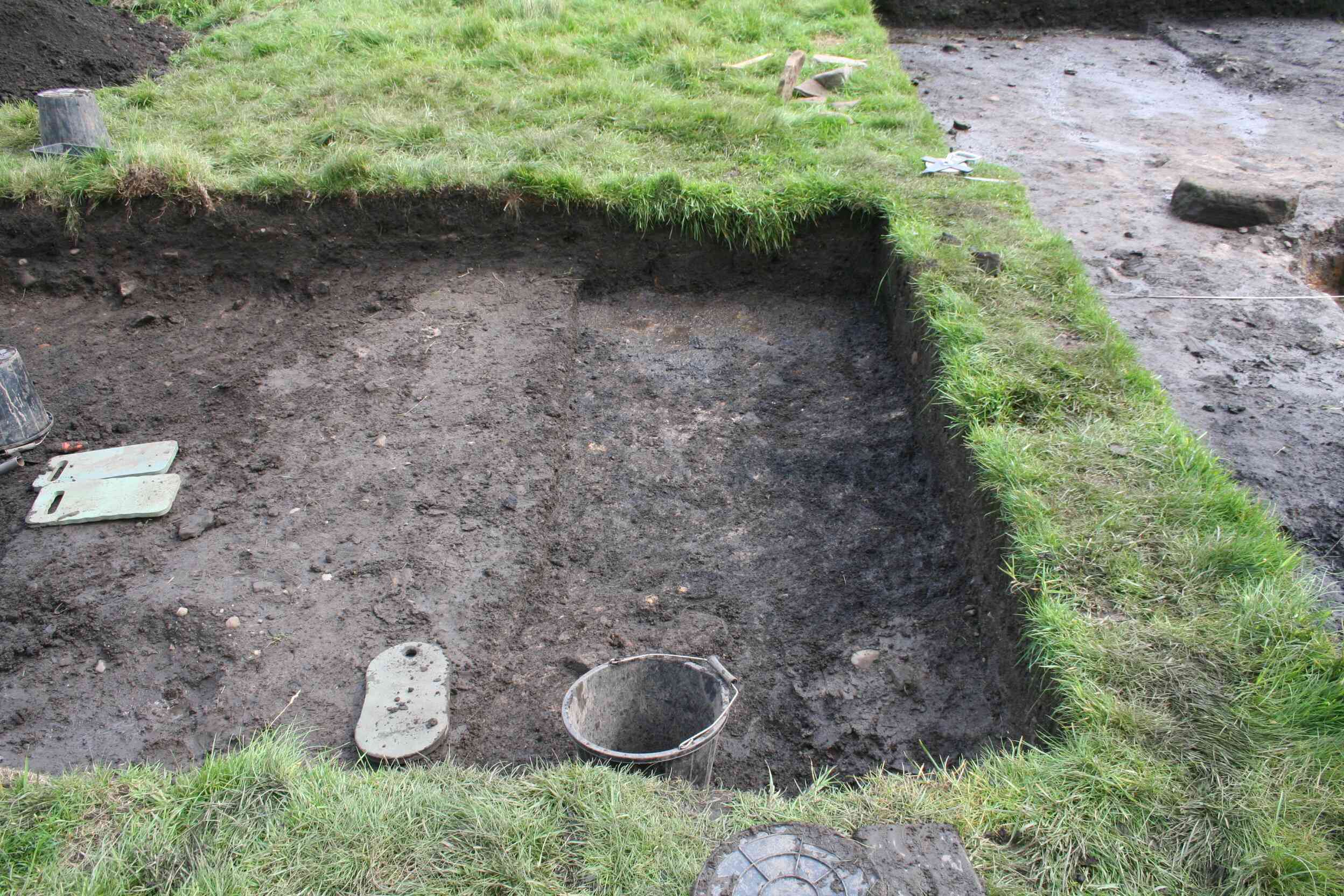
Photo 8

Photo 9
Weather: Cloudy with sunny periods, precipitation in afternoon
All the trenches need to be baled out and sponged due to the heavy rain experienced over the last few days.
Trench 1/Trench 3
Re turfing of trench 1 was started in the area which was backfilled during the last dig. The clay filled hole where the large stone had stood and the smithing area in the joined trench 3 were cleaned up as best as possible for photographing. Unfortunately seepage from the surrounding areas of the trenches made cleaning a hard job, and a heavy rain shower at the end of the day put paid to further cleaning. Photos 1 and 2
Trench 2
Closed down and backfilled previously.
Trench 4
Recording and level taking carried out in the trench prior to its closure and back filling. Re turfing will be carried out at the next dig.
Trench 5
Continued to clean the trench, main section of interest was in the northeast section close to the side of the trench. An orangey coloured clay section was exposed, with again what are assumed to be mole holes in it. One particular item of interest is a pointed stone protruding from the clay which has distinctive deep scratch marks on it. There is also a large block of slag just protruding from the east wall of the trench which will need excavating next year. Photo 3
The east west running trench (possibly a drain) uncovered during the last dig shows just how effective it would have been when originally dug. Photo 4
One of the areas of interest next year will be in trench 5 investigating the new furnace, the pointed stone and its markings, and the large slag block and the ditch feature. This will mean extending the trench to the north and east. For most of this season’s dig trench 5 appeared to hold very little if any archaeology, then typically at the end of the season, items start to appear.

Cinder Hill Field Trench Plan

Photo 2

Photo 1

Photo 3

Photo 4
HMHG Dig Saturday 5th October and Sunday 6th October.
Weather: overcast with sunny periods
The weekend work concentrated on completing the backfill of all the trenches, after baling them out, then re turfing them. The only exception was in trench 5 where a metre-wide strip on the east side of the trench has been left un-turfed. This is the area where the second bloomery, two very large pieces of slag and the east/west running trench were uncovered. As this will be the first area to be excavated in 2020 the turf has been left off to allow quick access.
A number of pictures of the area are attached which make the area look like a battlefield. It will, however, not take long for the grass to regrow. It will then be difficult to locate the 2019 trenches.
Please note as the backfill and re turfing went so well, the last scheduled dig which was due to take place on the 17th October has been cancelled.
Please do not forget Neil’s talk covering this year’s dig on Wednesday 16th October at the Greenmount Cricket Club at 19:30 hrs. Entrance £3.00 per person which includes refreshments. There is a bar available courtesy of the cricket Club.


Photo 1

Photo 2

Photo 3

Photo 4